Artificial Intelligence and Data Mining
VerifiedAdded on 2020/12/26
|29
|5886
|181
Report
AI Summary
This report investigates the effectiveness of artificial intelligence and integrated data mining in the Canadian manufacturing sector. It analyzes how these technologies can enhance business operations, improve financial performance, and identify opportunities for growth. The report also examines the challenges and limitations associated with implementing AI and data mining in manufacturing organizations.
Contribute Materials
Your contribution can guide someone’s learning journey. Share your
documents today.

Methods of Inquiry
Secure Best Marks with AI Grader
Need help grading? Try our AI Grader for instant feedback on your assignments.
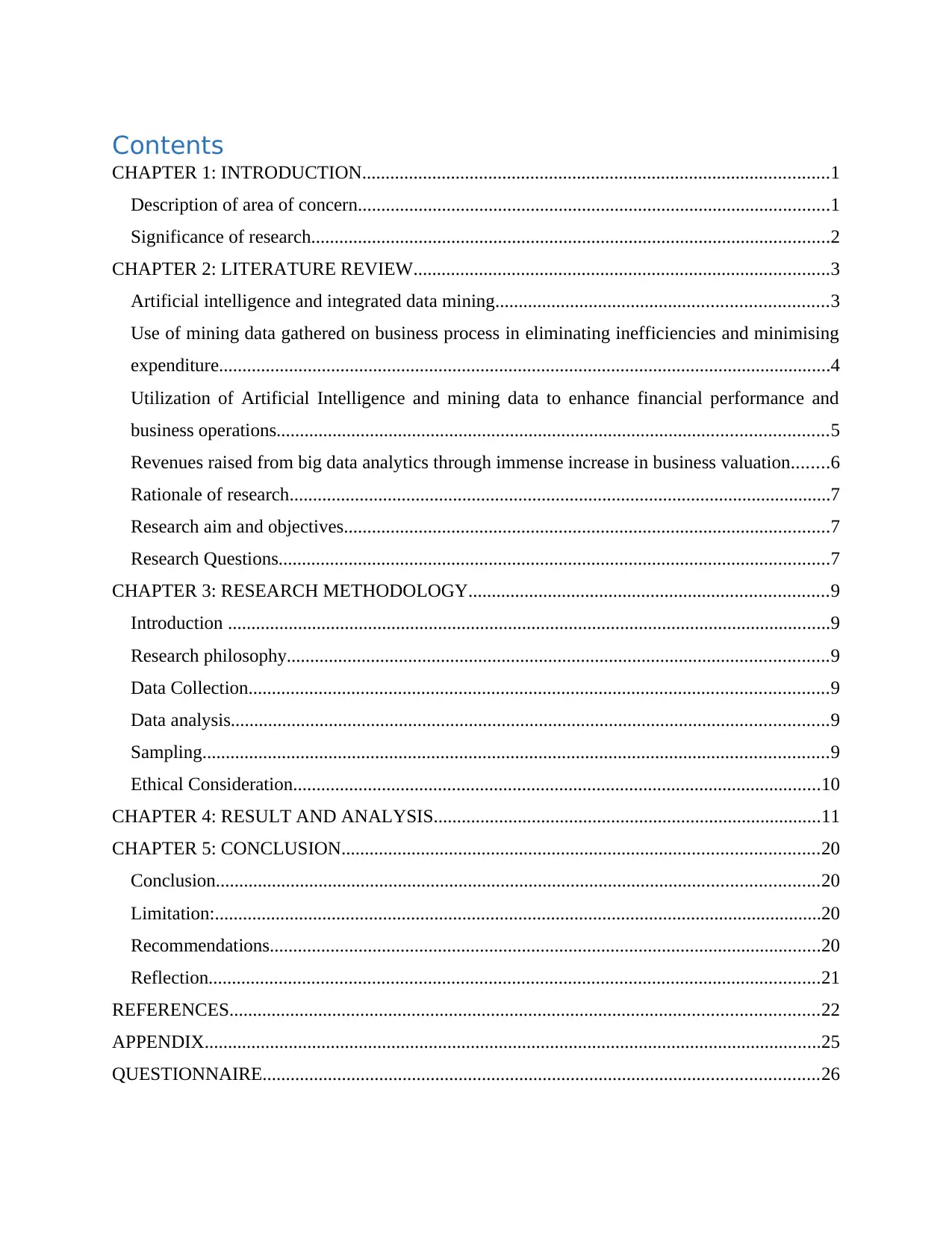
Contents
CHAPTER 1: INTRODUCTION....................................................................................................1
Description of area of concern.....................................................................................................1
Significance of research...............................................................................................................2
CHAPTER 2: LITERATURE REVIEW.........................................................................................3
Artificial intelligence and integrated data mining.......................................................................3
Use of mining data gathered on business process in eliminating inefficiencies and minimising
expenditure...................................................................................................................................4
Utilization of Artificial Intelligence and mining data to enhance financial performance and
business operations......................................................................................................................5
Revenues raised from big data analytics through immense increase in business valuation........6
Rationale of research....................................................................................................................7
Research aim and objectives........................................................................................................7
Research Questions......................................................................................................................7
CHAPTER 3: RESEARCH METHODOLOGY.............................................................................9
Introduction .................................................................................................................................9
Research philosophy....................................................................................................................9
Data Collection............................................................................................................................9
Data analysis................................................................................................................................9
Sampling......................................................................................................................................9
Ethical Consideration.................................................................................................................10
CHAPTER 4: RESULT AND ANALYSIS...................................................................................11
CHAPTER 5: CONCLUSION......................................................................................................20
Conclusion.................................................................................................................................20
Limitation:..................................................................................................................................20
Recommendations......................................................................................................................20
Reflection...................................................................................................................................21
REFERENCES..............................................................................................................................22
APPENDIX....................................................................................................................................25
QUESTIONNAIRE.......................................................................................................................26
CHAPTER 1: INTRODUCTION....................................................................................................1
Description of area of concern.....................................................................................................1
Significance of research...............................................................................................................2
CHAPTER 2: LITERATURE REVIEW.........................................................................................3
Artificial intelligence and integrated data mining.......................................................................3
Use of mining data gathered on business process in eliminating inefficiencies and minimising
expenditure...................................................................................................................................4
Utilization of Artificial Intelligence and mining data to enhance financial performance and
business operations......................................................................................................................5
Revenues raised from big data analytics through immense increase in business valuation........6
Rationale of research....................................................................................................................7
Research aim and objectives........................................................................................................7
Research Questions......................................................................................................................7
CHAPTER 3: RESEARCH METHODOLOGY.............................................................................9
Introduction .................................................................................................................................9
Research philosophy....................................................................................................................9
Data Collection............................................................................................................................9
Data analysis................................................................................................................................9
Sampling......................................................................................................................................9
Ethical Consideration.................................................................................................................10
CHAPTER 4: RESULT AND ANALYSIS...................................................................................11
CHAPTER 5: CONCLUSION......................................................................................................20
Conclusion.................................................................................................................................20
Limitation:..................................................................................................................................20
Recommendations......................................................................................................................20
Reflection...................................................................................................................................21
REFERENCES..............................................................................................................................22
APPENDIX....................................................................................................................................25
QUESTIONNAIRE.......................................................................................................................26
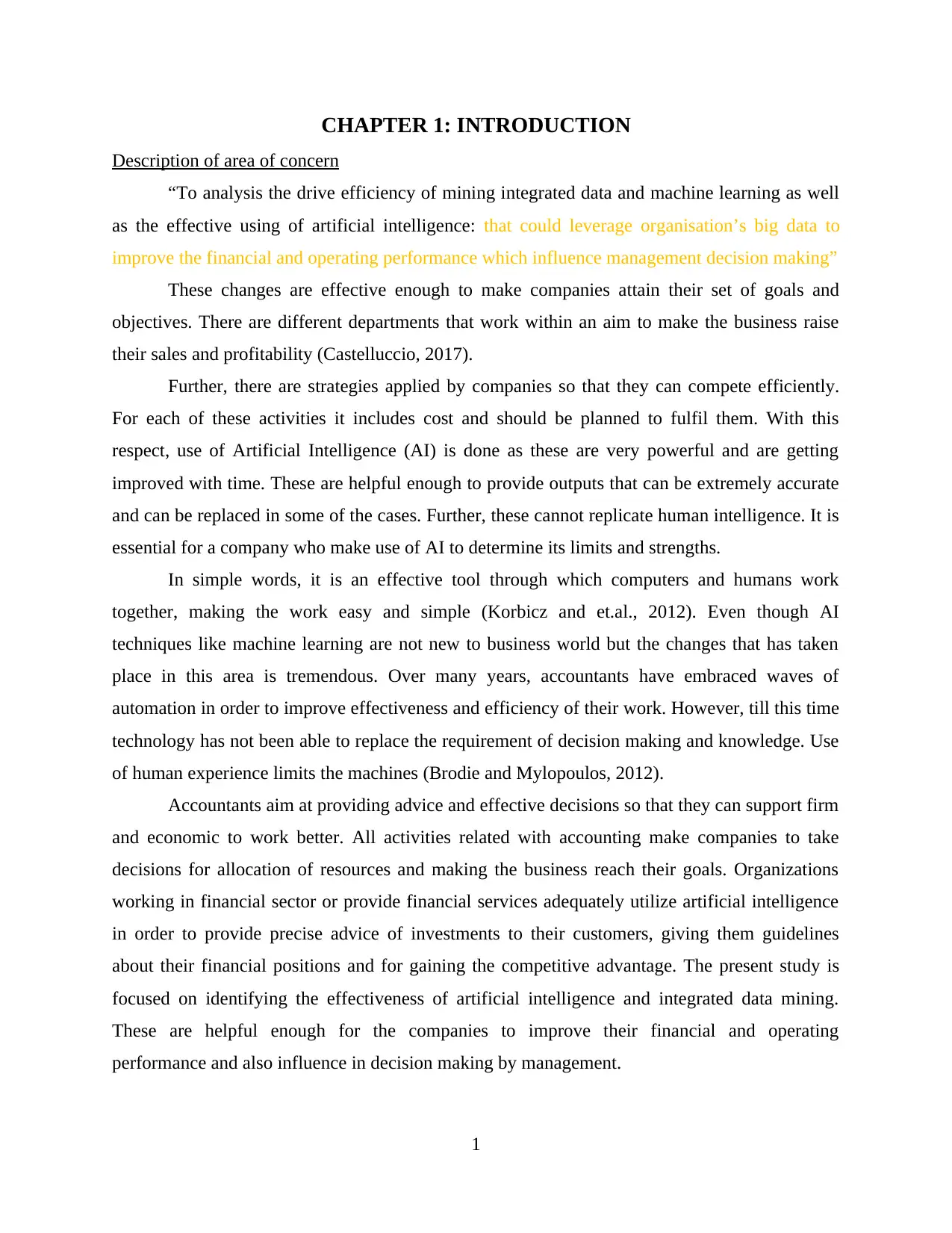
CHAPTER 1: INTRODUCTION
Description of area of concern
“To analysis the drive efficiency of mining integrated data and machine learning as well
as the effective using of artificial intelligence: that could leverage organisation’s big data to
improve the financial and operating performance which influence management decision making”
These changes are effective enough to make companies attain their set of goals and
objectives. There are different departments that work within an aim to make the business raise
their sales and profitability (Castelluccio, 2017).
Further, there are strategies applied by companies so that they can compete efficiently.
For each of these activities it includes cost and should be planned to fulfil them. With this
respect, use of Artificial Intelligence (AI) is done as these are very powerful and are getting
improved with time. These are helpful enough to provide outputs that can be extremely accurate
and can be replaced in some of the cases. Further, these cannot replicate human intelligence. It is
essential for a company who make use of AI to determine its limits and strengths.
In simple words, it is an effective tool through which computers and humans work
together, making the work easy and simple (Korbicz and et.al., 2012). Even though AI
techniques like machine learning are not new to business world but the changes that has taken
place in this area is tremendous. Over many years, accountants have embraced waves of
automation in order to improve effectiveness and efficiency of their work. However, till this time
technology has not been able to replace the requirement of decision making and knowledge. Use
of human experience limits the machines (Brodie and Mylopoulos, 2012).
Accountants aim at providing advice and effective decisions so that they can support firm
and economic to work better. All activities related with accounting make companies to take
decisions for allocation of resources and making the business reach their goals. Organizations
working in financial sector or provide financial services adequately utilize artificial intelligence
in order to provide precise advice of investments to their customers, giving them guidelines
about their financial positions and for gaining the competitive advantage. The present study is
focused on identifying the effectiveness of artificial intelligence and integrated data mining.
These are helpful enough for the companies to improve their financial and operating
performance and also influence in decision making by management.
1
Description of area of concern
“To analysis the drive efficiency of mining integrated data and machine learning as well
as the effective using of artificial intelligence: that could leverage organisation’s big data to
improve the financial and operating performance which influence management decision making”
These changes are effective enough to make companies attain their set of goals and
objectives. There are different departments that work within an aim to make the business raise
their sales and profitability (Castelluccio, 2017).
Further, there are strategies applied by companies so that they can compete efficiently.
For each of these activities it includes cost and should be planned to fulfil them. With this
respect, use of Artificial Intelligence (AI) is done as these are very powerful and are getting
improved with time. These are helpful enough to provide outputs that can be extremely accurate
and can be replaced in some of the cases. Further, these cannot replicate human intelligence. It is
essential for a company who make use of AI to determine its limits and strengths.
In simple words, it is an effective tool through which computers and humans work
together, making the work easy and simple (Korbicz and et.al., 2012). Even though AI
techniques like machine learning are not new to business world but the changes that has taken
place in this area is tremendous. Over many years, accountants have embraced waves of
automation in order to improve effectiveness and efficiency of their work. However, till this time
technology has not been able to replace the requirement of decision making and knowledge. Use
of human experience limits the machines (Brodie and Mylopoulos, 2012).
Accountants aim at providing advice and effective decisions so that they can support firm
and economic to work better. All activities related with accounting make companies to take
decisions for allocation of resources and making the business reach their goals. Organizations
working in financial sector or provide financial services adequately utilize artificial intelligence
in order to provide precise advice of investments to their customers, giving them guidelines
about their financial positions and for gaining the competitive advantage. The present study is
focused on identifying the effectiveness of artificial intelligence and integrated data mining.
These are helpful enough for the companies to improve their financial and operating
performance and also influence in decision making by management.
1
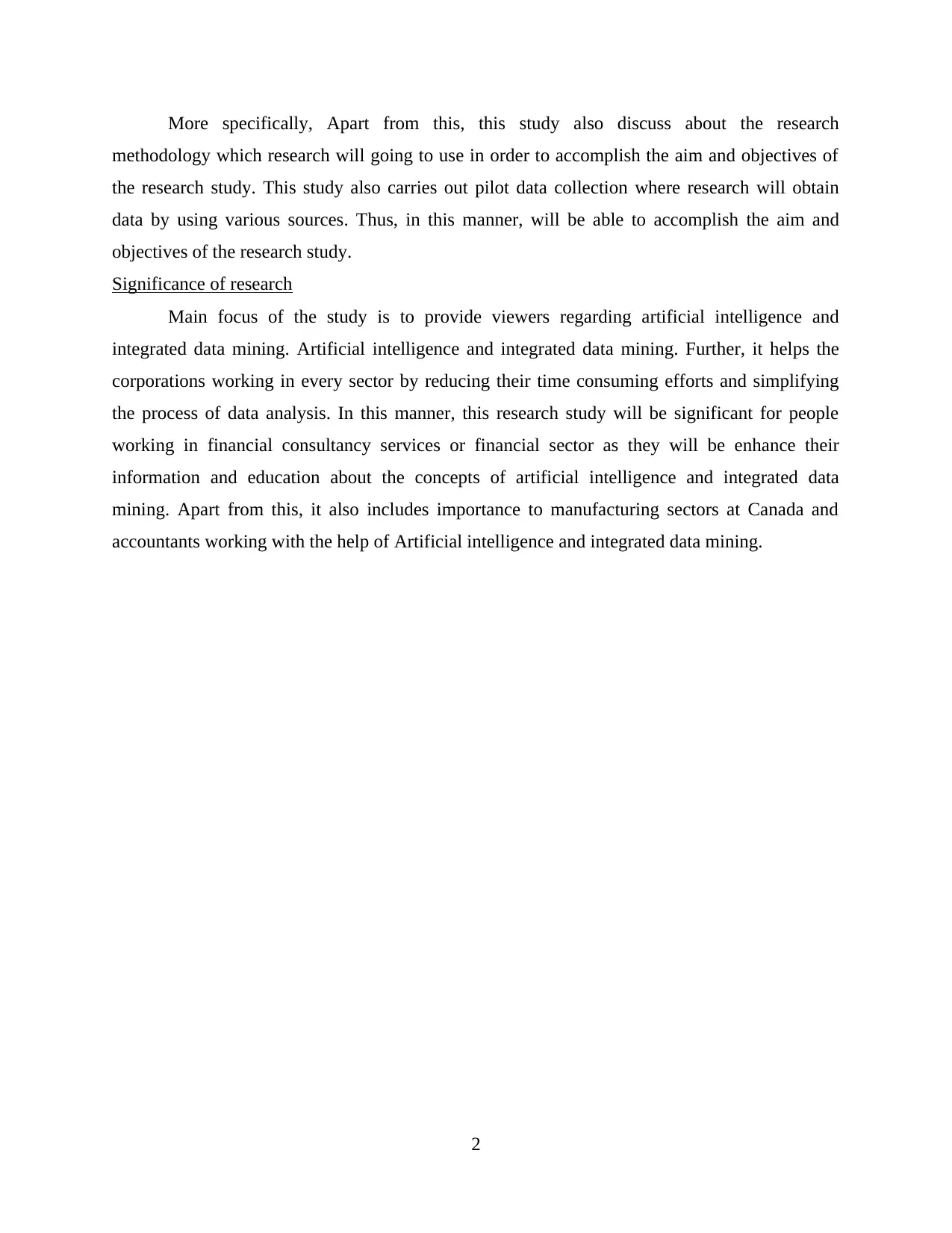
More specifically, Apart from this, this study also discuss about the research
methodology which research will going to use in order to accomplish the aim and objectives of
the research study. This study also carries out pilot data collection where research will obtain
data by using various sources. Thus, in this manner, will be able to accomplish the aim and
objectives of the research study.
Significance of research
Main focus of the study is to provide viewers regarding artificial intelligence and
integrated data mining. Artificial intelligence and integrated data mining. Further, it helps the
corporations working in every sector by reducing their time consuming efforts and simplifying
the process of data analysis. In this manner, this research study will be significant for people
working in financial consultancy services or financial sector as they will be enhance their
information and education about the concepts of artificial intelligence and integrated data
mining. Apart from this, it also includes importance to manufacturing sectors at Canada and
accountants working with the help of Artificial intelligence and integrated data mining.
2
methodology which research will going to use in order to accomplish the aim and objectives of
the research study. This study also carries out pilot data collection where research will obtain
data by using various sources. Thus, in this manner, will be able to accomplish the aim and
objectives of the research study.
Significance of research
Main focus of the study is to provide viewers regarding artificial intelligence and
integrated data mining. Artificial intelligence and integrated data mining. Further, it helps the
corporations working in every sector by reducing their time consuming efforts and simplifying
the process of data analysis. In this manner, this research study will be significant for people
working in financial consultancy services or financial sector as they will be enhance their
information and education about the concepts of artificial intelligence and integrated data
mining. Apart from this, it also includes importance to manufacturing sectors at Canada and
accountants working with the help of Artificial intelligence and integrated data mining.
2
Secure Best Marks with AI Grader
Need help grading? Try our AI Grader for instant feedback on your assignments.
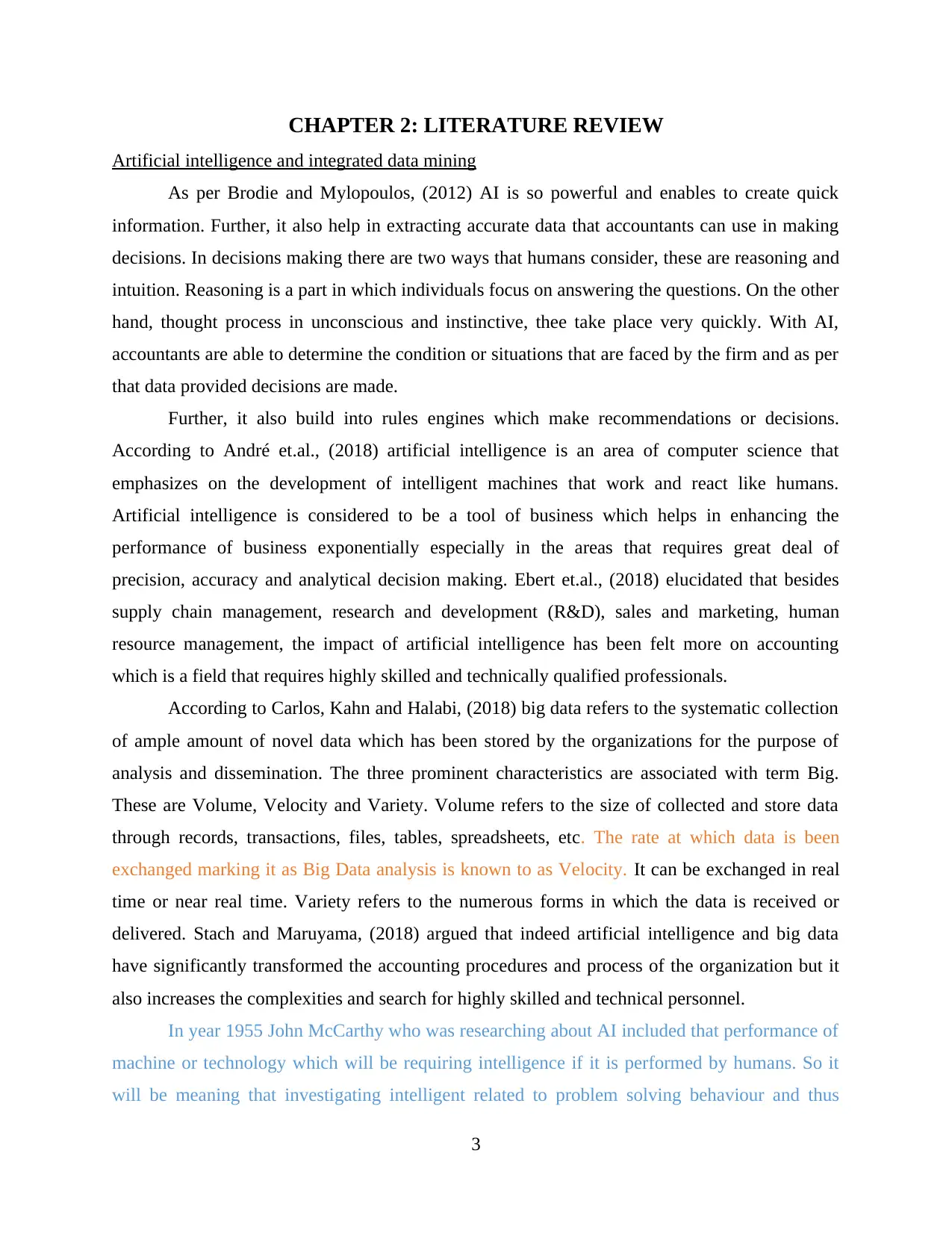
CHAPTER 2: LITERATURE REVIEW
Artificial intelligence and integrated data mining
As per Brodie and Mylopoulos, (2012) AI is so powerful and enables to create quick
information. Further, it also help in extracting accurate data that accountants can use in making
decisions. In decisions making there are two ways that humans consider, these are reasoning and
intuition. Reasoning is a part in which individuals focus on answering the questions. On the other
hand, thought process in unconscious and instinctive, thee take place very quickly. With AI,
accountants are able to determine the condition or situations that are faced by the firm and as per
that data provided decisions are made.
Further, it also build into rules engines which make recommendations or decisions.
According to André et.al., (2018) artificial intelligence is an area of computer science that
emphasizes on the development of intelligent machines that work and react like humans.
Artificial intelligence is considered to be a tool of business which helps in enhancing the
performance of business exponentially especially in the areas that requires great deal of
precision, accuracy and analytical decision making. Ebert et.al., (2018) elucidated that besides
supply chain management, research and development (R&D), sales and marketing, human
resource management, the impact of artificial intelligence has been felt more on accounting
which is a field that requires highly skilled and technically qualified professionals.
According to Carlos, Kahn and Halabi, (2018) big data refers to the systematic collection
of ample amount of novel data which has been stored by the organizations for the purpose of
analysis and dissemination. The three prominent characteristics are associated with term Big.
These are Volume, Velocity and Variety. Volume refers to the size of collected and store data
through records, transactions, files, tables, spreadsheets, etc. The rate at which data is been
exchanged marking it as Big Data analysis is known to as Velocity. It can be exchanged in real
time or near real time. Variety refers to the numerous forms in which the data is received or
delivered. Stach and Maruyama, (2018) argued that indeed artificial intelligence and big data
have significantly transformed the accounting procedures and process of the organization but it
also increases the complexities and search for highly skilled and technical personnel.
In year 1955 John McCarthy who was researching about AI included that performance of
machine or technology which will be requiring intelligence if it is performed by humans. So it
will be meaning that investigating intelligent related to problem solving behaviour and thus
3
Artificial intelligence and integrated data mining
As per Brodie and Mylopoulos, (2012) AI is so powerful and enables to create quick
information. Further, it also help in extracting accurate data that accountants can use in making
decisions. In decisions making there are two ways that humans consider, these are reasoning and
intuition. Reasoning is a part in which individuals focus on answering the questions. On the other
hand, thought process in unconscious and instinctive, thee take place very quickly. With AI,
accountants are able to determine the condition or situations that are faced by the firm and as per
that data provided decisions are made.
Further, it also build into rules engines which make recommendations or decisions.
According to André et.al., (2018) artificial intelligence is an area of computer science that
emphasizes on the development of intelligent machines that work and react like humans.
Artificial intelligence is considered to be a tool of business which helps in enhancing the
performance of business exponentially especially in the areas that requires great deal of
precision, accuracy and analytical decision making. Ebert et.al., (2018) elucidated that besides
supply chain management, research and development (R&D), sales and marketing, human
resource management, the impact of artificial intelligence has been felt more on accounting
which is a field that requires highly skilled and technically qualified professionals.
According to Carlos, Kahn and Halabi, (2018) big data refers to the systematic collection
of ample amount of novel data which has been stored by the organizations for the purpose of
analysis and dissemination. The three prominent characteristics are associated with term Big.
These are Volume, Velocity and Variety. Volume refers to the size of collected and store data
through records, transactions, files, tables, spreadsheets, etc. The rate at which data is been
exchanged marking it as Big Data analysis is known to as Velocity. It can be exchanged in real
time or near real time. Variety refers to the numerous forms in which the data is received or
delivered. Stach and Maruyama, (2018) argued that indeed artificial intelligence and big data
have significantly transformed the accounting procedures and process of the organization but it
also increases the complexities and search for highly skilled and technical personnel.
In year 1955 John McCarthy who was researching about AI included that performance of
machine or technology which will be requiring intelligence if it is performed by humans. So it
will be meaning that investigating intelligent related to problem solving behaviour and thus
3
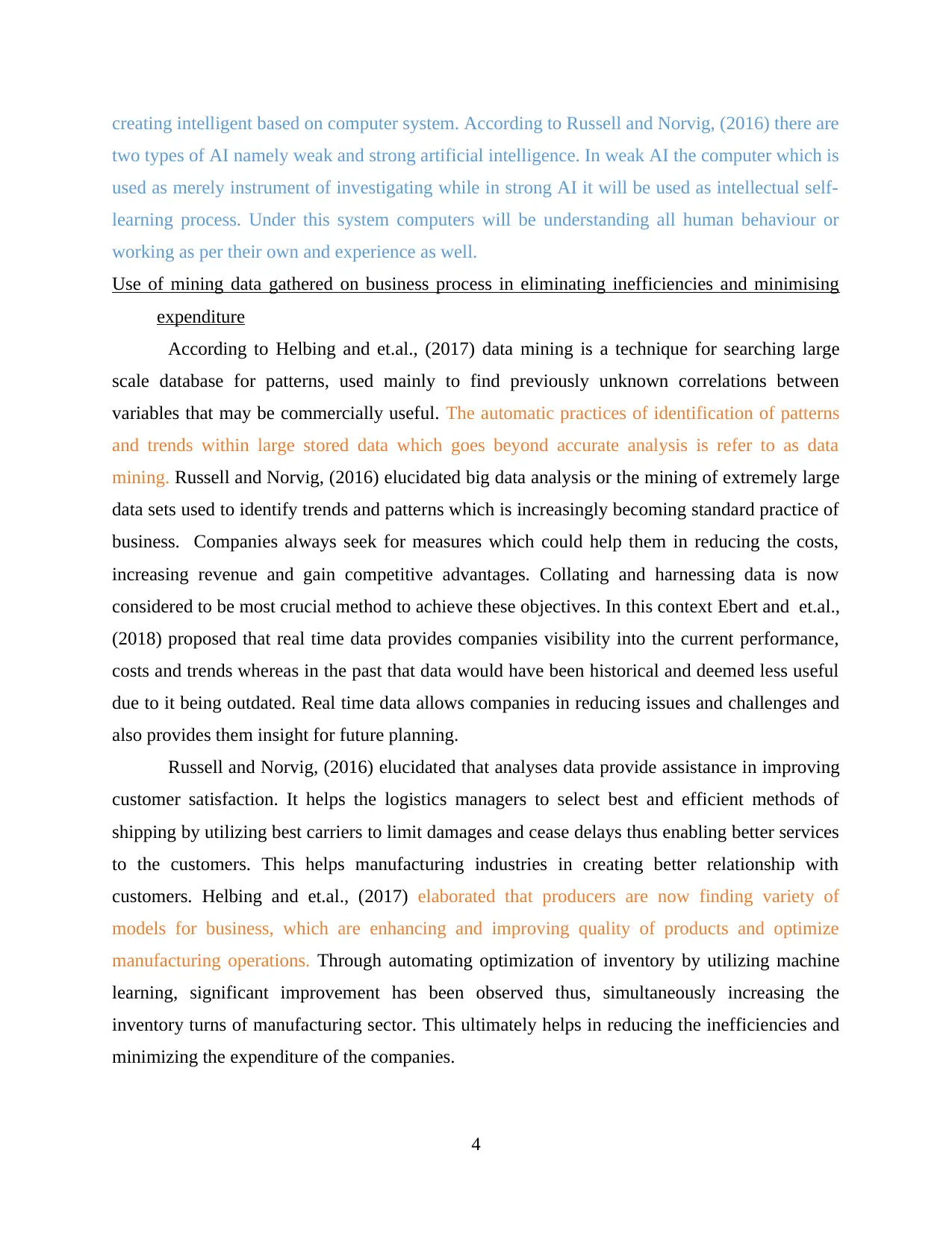
creating intelligent based on computer system. According to Russell and Norvig, (2016) there are
two types of AI namely weak and strong artificial intelligence. In weak AI the computer which is
used as merely instrument of investigating while in strong AI it will be used as intellectual self-
learning process. Under this system computers will be understanding all human behaviour or
working as per their own and experience as well.
Use of mining data gathered on business process in eliminating inefficiencies and minimising
expenditure
According to Helbing and et.al., (2017) data mining is a technique for searching large
scale database for patterns, used mainly to find previously unknown correlations between
variables that may be commercially useful. The automatic practices of identification of patterns
and trends within large stored data which goes beyond accurate analysis is refer to as data
mining. Russell and Norvig, (2016) elucidated big data analysis or the mining of extremely large
data sets used to identify trends and patterns which is increasingly becoming standard practice of
business. Companies always seek for measures which could help them in reducing the costs,
increasing revenue and gain competitive advantages. Collating and harnessing data is now
considered to be most crucial method to achieve these objectives. In this context Ebert and et.al.,
(2018) proposed that real time data provides companies visibility into the current performance,
costs and trends whereas in the past that data would have been historical and deemed less useful
due to it being outdated. Real time data allows companies in reducing issues and challenges and
also provides them insight for future planning.
Russell and Norvig, (2016) elucidated that analyses data provide assistance in improving
customer satisfaction. It helps the logistics managers to select best and efficient methods of
shipping by utilizing best carriers to limit damages and cease delays thus enabling better services
to the customers. This helps manufacturing industries in creating better relationship with
customers. Helbing and et.al., (2017) elaborated that producers are now finding variety of
models for business, which are enhancing and improving quality of products and optimize
manufacturing operations. Through automating optimization of inventory by utilizing machine
learning, significant improvement has been observed thus, simultaneously increasing the
inventory turns of manufacturing sector. This ultimately helps in reducing the inefficiencies and
minimizing the expenditure of the companies.
4
two types of AI namely weak and strong artificial intelligence. In weak AI the computer which is
used as merely instrument of investigating while in strong AI it will be used as intellectual self-
learning process. Under this system computers will be understanding all human behaviour or
working as per their own and experience as well.
Use of mining data gathered on business process in eliminating inefficiencies and minimising
expenditure
According to Helbing and et.al., (2017) data mining is a technique for searching large
scale database for patterns, used mainly to find previously unknown correlations between
variables that may be commercially useful. The automatic practices of identification of patterns
and trends within large stored data which goes beyond accurate analysis is refer to as data
mining. Russell and Norvig, (2016) elucidated big data analysis or the mining of extremely large
data sets used to identify trends and patterns which is increasingly becoming standard practice of
business. Companies always seek for measures which could help them in reducing the costs,
increasing revenue and gain competitive advantages. Collating and harnessing data is now
considered to be most crucial method to achieve these objectives. In this context Ebert and et.al.,
(2018) proposed that real time data provides companies visibility into the current performance,
costs and trends whereas in the past that data would have been historical and deemed less useful
due to it being outdated. Real time data allows companies in reducing issues and challenges and
also provides them insight for future planning.
Russell and Norvig, (2016) elucidated that analyses data provide assistance in improving
customer satisfaction. It helps the logistics managers to select best and efficient methods of
shipping by utilizing best carriers to limit damages and cease delays thus enabling better services
to the customers. This helps manufacturing industries in creating better relationship with
customers. Helbing and et.al., (2017) elaborated that producers are now finding variety of
models for business, which are enhancing and improving quality of products and optimize
manufacturing operations. Through automating optimization of inventory by utilizing machine
learning, significant improvement has been observed thus, simultaneously increasing the
inventory turns of manufacturing sector. This ultimately helps in reducing the inefficiencies and
minimizing the expenditure of the companies.
4
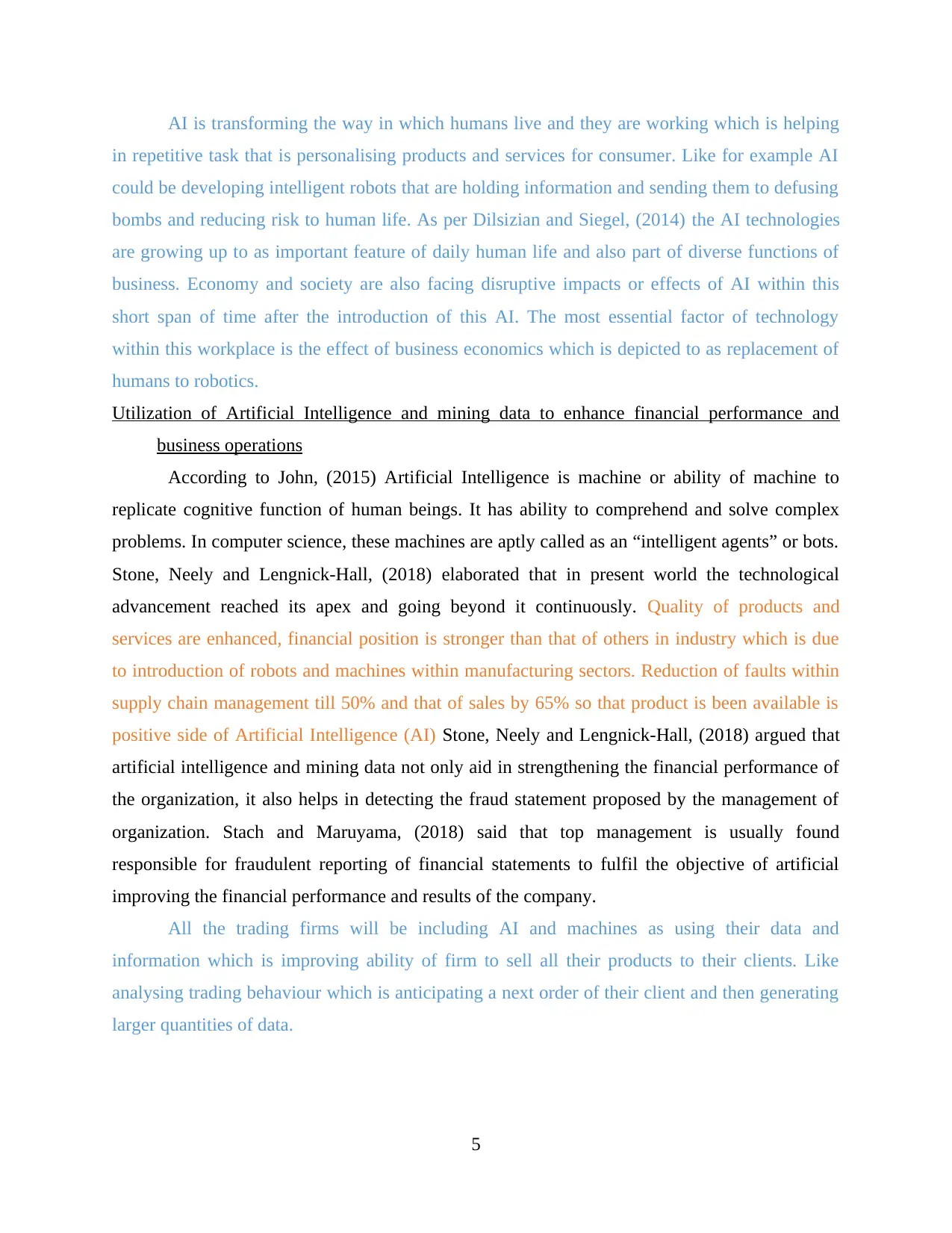
AI is transforming the way in which humans live and they are working which is helping
in repetitive task that is personalising products and services for consumer. Like for example AI
could be developing intelligent robots that are holding information and sending them to defusing
bombs and reducing risk to human life. As per Dilsizian and Siegel, (2014) the AI technologies
are growing up to as important feature of daily human life and also part of diverse functions of
business. Economy and society are also facing disruptive impacts or effects of AI within this
short span of time after the introduction of this AI. The most essential factor of technology
within this workplace is the effect of business economics which is depicted to as replacement of
humans to robotics.
Utilization of Artificial Intelligence and mining data to enhance financial performance and
business operations
According to John, (2015) Artificial Intelligence is machine or ability of machine to
replicate cognitive function of human beings. It has ability to comprehend and solve complex
problems. In computer science, these machines are aptly called as an “intelligent agents” or bots.
Stone, Neely and Lengnick-Hall, (2018) elaborated that in present world the technological
advancement reached its apex and going beyond it continuously. Quality of products and
services are enhanced, financial position is stronger than that of others in industry which is due
to introduction of robots and machines within manufacturing sectors. Reduction of faults within
supply chain management till 50% and that of sales by 65% so that product is been available is
positive side of Artificial Intelligence (AI) Stone, Neely and Lengnick-Hall, (2018) argued that
artificial intelligence and mining data not only aid in strengthening the financial performance of
the organization, it also helps in detecting the fraud statement proposed by the management of
organization. Stach and Maruyama, (2018) said that top management is usually found
responsible for fraudulent reporting of financial statements to fulfil the objective of artificial
improving the financial performance and results of the company.
All the trading firms will be including AI and machines as using their data and
information which is improving ability of firm to sell all their products to their clients. Like
analysing trading behaviour which is anticipating a next order of their client and then generating
larger quantities of data.
5
in repetitive task that is personalising products and services for consumer. Like for example AI
could be developing intelligent robots that are holding information and sending them to defusing
bombs and reducing risk to human life. As per Dilsizian and Siegel, (2014) the AI technologies
are growing up to as important feature of daily human life and also part of diverse functions of
business. Economy and society are also facing disruptive impacts or effects of AI within this
short span of time after the introduction of this AI. The most essential factor of technology
within this workplace is the effect of business economics which is depicted to as replacement of
humans to robotics.
Utilization of Artificial Intelligence and mining data to enhance financial performance and
business operations
According to John, (2015) Artificial Intelligence is machine or ability of machine to
replicate cognitive function of human beings. It has ability to comprehend and solve complex
problems. In computer science, these machines are aptly called as an “intelligent agents” or bots.
Stone, Neely and Lengnick-Hall, (2018) elaborated that in present world the technological
advancement reached its apex and going beyond it continuously. Quality of products and
services are enhanced, financial position is stronger than that of others in industry which is due
to introduction of robots and machines within manufacturing sectors. Reduction of faults within
supply chain management till 50% and that of sales by 65% so that product is been available is
positive side of Artificial Intelligence (AI) Stone, Neely and Lengnick-Hall, (2018) argued that
artificial intelligence and mining data not only aid in strengthening the financial performance of
the organization, it also helps in detecting the fraud statement proposed by the management of
organization. Stach and Maruyama, (2018) said that top management is usually found
responsible for fraudulent reporting of financial statements to fulfil the objective of artificial
improving the financial performance and results of the company.
All the trading firms will be including AI and machines as using their data and
information which is improving ability of firm to sell all their products to their clients. Like
analysing trading behaviour which is anticipating a next order of their client and then generating
larger quantities of data.
5
Paraphrase This Document
Need a fresh take? Get an instant paraphrase of this document with our AI Paraphraser
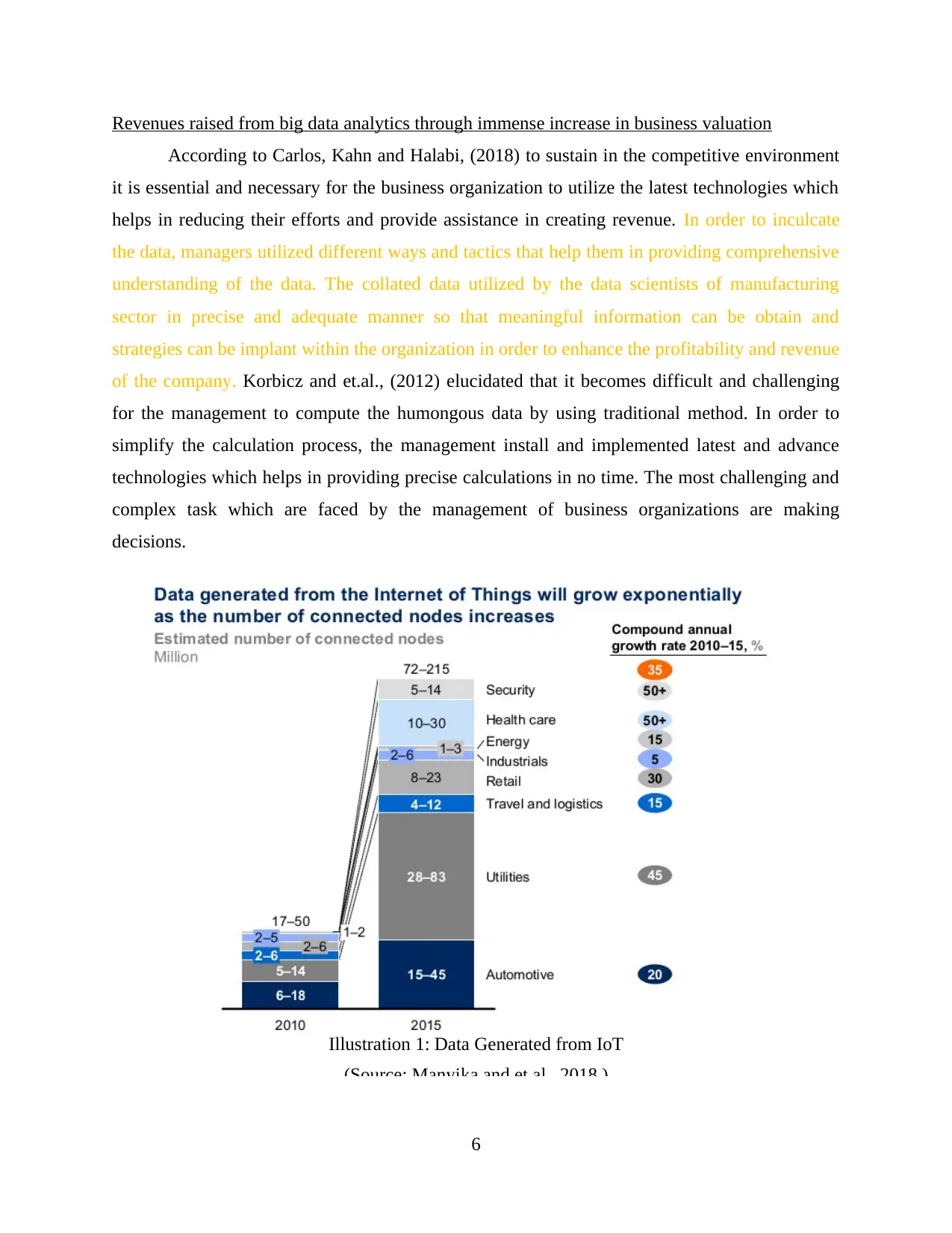
Revenues raised from big data analytics through immense increase in business valuation
According to Carlos, Kahn and Halabi, (2018) to sustain in the competitive environment
it is essential and necessary for the business organization to utilize the latest technologies which
helps in reducing their efforts and provide assistance in creating revenue. In order to inculcate
the data, managers utilized different ways and tactics that help them in providing comprehensive
understanding of the data. The collated data utilized by the data scientists of manufacturing
sector in precise and adequate manner so that meaningful information can be obtain and
strategies can be implant within the organization in order to enhance the profitability and revenue
of the company. Korbicz and et.al., (2012) elucidated that it becomes difficult and challenging
for the management to compute the humongous data by using traditional method. In order to
simplify the calculation process, the management install and implemented latest and advance
technologies which helps in providing precise calculations in no time. The most challenging and
complex task which are faced by the management of business organizations are making
decisions.
6
Illustration 1: Data Generated from IoT
(Source: Manyika and et.al., 2018 )
According to Carlos, Kahn and Halabi, (2018) to sustain in the competitive environment
it is essential and necessary for the business organization to utilize the latest technologies which
helps in reducing their efforts and provide assistance in creating revenue. In order to inculcate
the data, managers utilized different ways and tactics that help them in providing comprehensive
understanding of the data. The collated data utilized by the data scientists of manufacturing
sector in precise and adequate manner so that meaningful information can be obtain and
strategies can be implant within the organization in order to enhance the profitability and revenue
of the company. Korbicz and et.al., (2012) elucidated that it becomes difficult and challenging
for the management to compute the humongous data by using traditional method. In order to
simplify the calculation process, the management install and implemented latest and advance
technologies which helps in providing precise calculations in no time. The most challenging and
complex task which are faced by the management of business organizations are making
decisions.
6
Illustration 1: Data Generated from IoT
(Source: Manyika and et.al., 2018 )
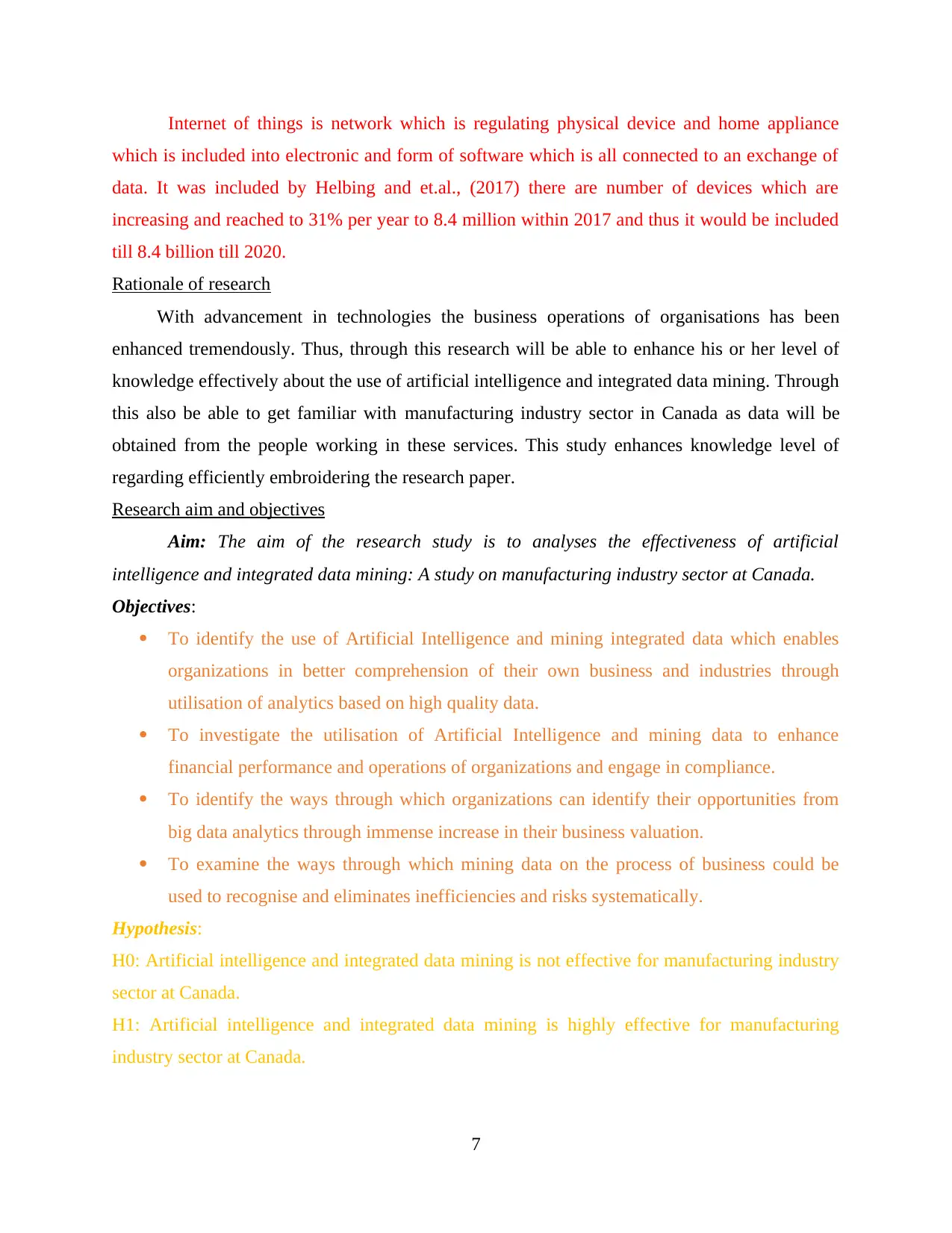
Internet of things is network which is regulating physical device and home appliance
which is included into electronic and form of software which is all connected to an exchange of
data. It was included by Helbing and et.al., (2017) there are number of devices which are
increasing and reached to 31% per year to 8.4 million within 2017 and thus it would be included
till 8.4 billion till 2020.
Rationale of research
With advancement in technologies the business operations of organisations has been
enhanced tremendously. Thus, through this research will be able to enhance his or her level of
knowledge effectively about the use of artificial intelligence and integrated data mining. Through
this also be able to get familiar with manufacturing industry sector in Canada as data will be
obtained from the people working in these services. This study enhances knowledge level of
regarding efficiently embroidering the research paper.
Research aim and objectives
Aim: The aim of the research study is to analyses the effectiveness of artificial
intelligence and integrated data mining: A study on manufacturing industry sector at Canada.
Objectives:
To identify the use of Artificial Intelligence and mining integrated data which enables
organizations in better comprehension of their own business and industries through
utilisation of analytics based on high quality data.
To investigate the utilisation of Artificial Intelligence and mining data to enhance
financial performance and operations of organizations and engage in compliance.
To identify the ways through which organizations can identify their opportunities from
big data analytics through immense increase in their business valuation.
To examine the ways through which mining data on the process of business could be
used to recognise and eliminates inefficiencies and risks systematically.
Hypothesis:
H0: Artificial intelligence and integrated data mining is not effective for manufacturing industry
sector at Canada.
H1: Artificial intelligence and integrated data mining is highly effective for manufacturing
industry sector at Canada.
7
which is included into electronic and form of software which is all connected to an exchange of
data. It was included by Helbing and et.al., (2017) there are number of devices which are
increasing and reached to 31% per year to 8.4 million within 2017 and thus it would be included
till 8.4 billion till 2020.
Rationale of research
With advancement in technologies the business operations of organisations has been
enhanced tremendously. Thus, through this research will be able to enhance his or her level of
knowledge effectively about the use of artificial intelligence and integrated data mining. Through
this also be able to get familiar with manufacturing industry sector in Canada as data will be
obtained from the people working in these services. This study enhances knowledge level of
regarding efficiently embroidering the research paper.
Research aim and objectives
Aim: The aim of the research study is to analyses the effectiveness of artificial
intelligence and integrated data mining: A study on manufacturing industry sector at Canada.
Objectives:
To identify the use of Artificial Intelligence and mining integrated data which enables
organizations in better comprehension of their own business and industries through
utilisation of analytics based on high quality data.
To investigate the utilisation of Artificial Intelligence and mining data to enhance
financial performance and operations of organizations and engage in compliance.
To identify the ways through which organizations can identify their opportunities from
big data analytics through immense increase in their business valuation.
To examine the ways through which mining data on the process of business could be
used to recognise and eliminates inefficiencies and risks systematically.
Hypothesis:
H0: Artificial intelligence and integrated data mining is not effective for manufacturing industry
sector at Canada.
H1: Artificial intelligence and integrated data mining is highly effective for manufacturing
industry sector at Canada.
7
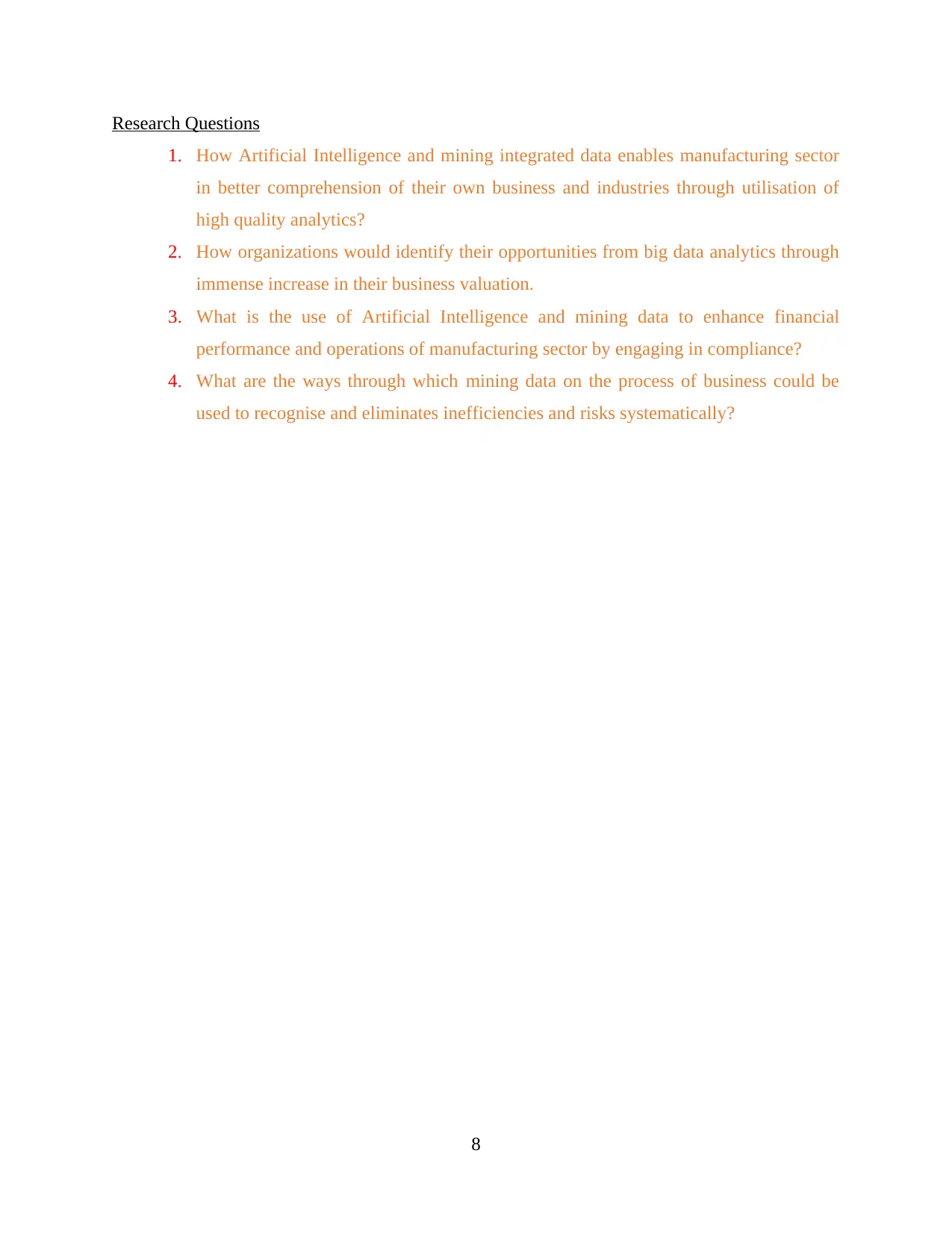
Research Questions
1. How Artificial Intelligence and mining integrated data enables manufacturing sector
in better comprehension of their own business and industries through utilisation of
high quality analytics?
2. How organizations would identify their opportunities from big data analytics through
immense increase in their business valuation.
3. What is the use of Artificial Intelligence and mining data to enhance financial
performance and operations of manufacturing sector by engaging in compliance?
4. What are the ways through which mining data on the process of business could be
used to recognise and eliminates inefficiencies and risks systematically?
8
1. How Artificial Intelligence and mining integrated data enables manufacturing sector
in better comprehension of their own business and industries through utilisation of
high quality analytics?
2. How organizations would identify their opportunities from big data analytics through
immense increase in their business valuation.
3. What is the use of Artificial Intelligence and mining data to enhance financial
performance and operations of manufacturing sector by engaging in compliance?
4. What are the ways through which mining data on the process of business could be
used to recognise and eliminates inefficiencies and risks systematically?
8
Secure Best Marks with AI Grader
Need help grading? Try our AI Grader for instant feedback on your assignments.
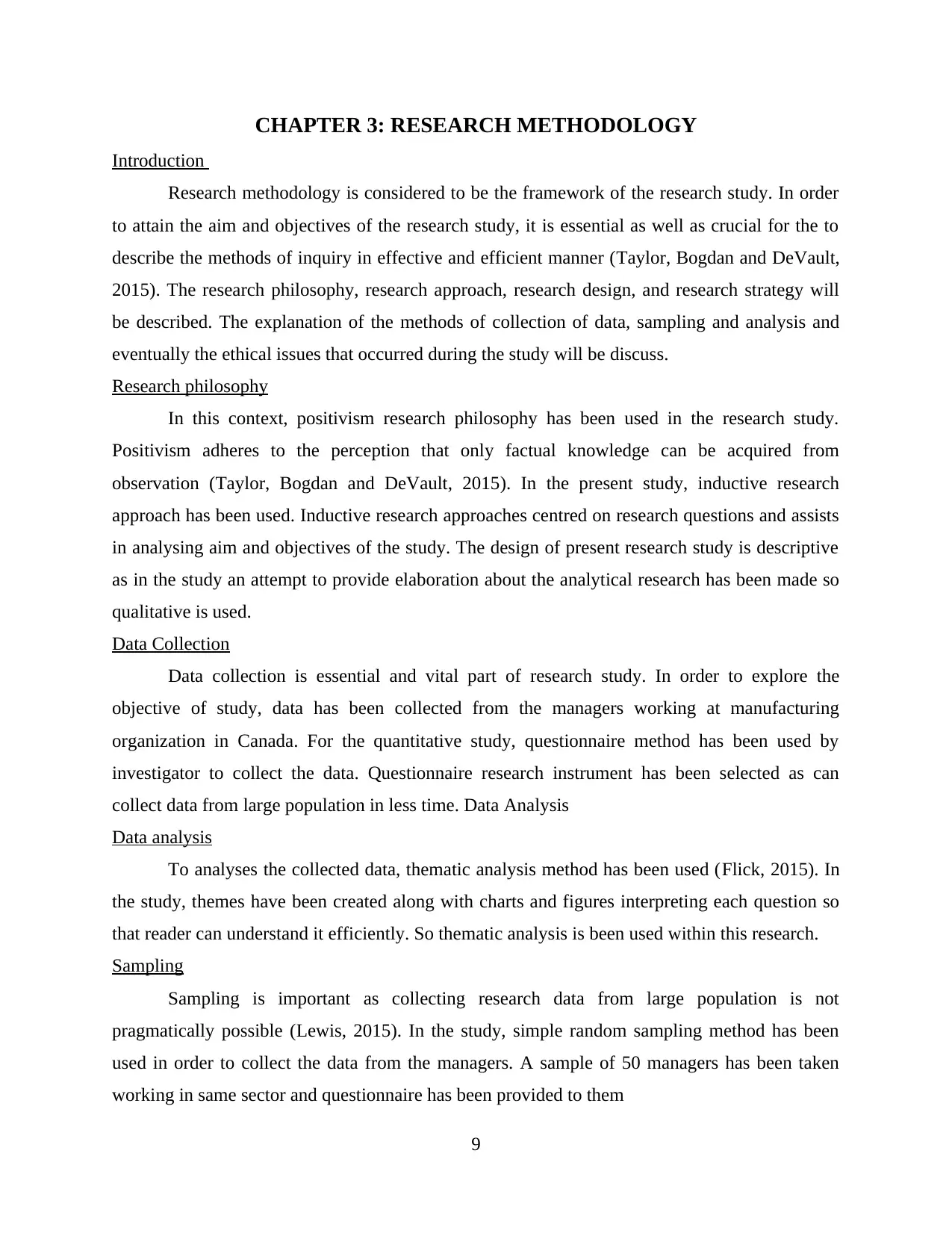
CHAPTER 3: RESEARCH METHODOLOGY
Introduction
Research methodology is considered to be the framework of the research study. In order
to attain the aim and objectives of the research study, it is essential as well as crucial for the to
describe the methods of inquiry in effective and efficient manner (Taylor, Bogdan and DeVault,
2015). The research philosophy, research approach, research design, and research strategy will
be described. The explanation of the methods of collection of data, sampling and analysis and
eventually the ethical issues that occurred during the study will be discuss.
Research philosophy
In this context, positivism research philosophy has been used in the research study.
Positivism adheres to the perception that only factual knowledge can be acquired from
observation (Taylor, Bogdan and DeVault, 2015). In the present study, inductive research
approach has been used. Inductive research approaches centred on research questions and assists
in analysing aim and objectives of the study. The design of present research study is descriptive
as in the study an attempt to provide elaboration about the analytical research has been made so
qualitative is used.
Data Collection
Data collection is essential and vital part of research study. In order to explore the
objective of study, data has been collected from the managers working at manufacturing
organization in Canada. For the quantitative study, questionnaire method has been used by
investigator to collect the data. Questionnaire research instrument has been selected as can
collect data from large population in less time. Data Analysis
Data analysis
To analyses the collected data, thematic analysis method has been used (Flick, 2015). In
the study, themes have been created along with charts and figures interpreting each question so
that reader can understand it efficiently. So thematic analysis is been used within this research.
Sampling
Sampling is important as collecting research data from large population is not
pragmatically possible (Lewis, 2015). In the study, simple random sampling method has been
used in order to collect the data from the managers. A sample of 50 managers has been taken
working in same sector and questionnaire has been provided to them
9
Introduction
Research methodology is considered to be the framework of the research study. In order
to attain the aim and objectives of the research study, it is essential as well as crucial for the to
describe the methods of inquiry in effective and efficient manner (Taylor, Bogdan and DeVault,
2015). The research philosophy, research approach, research design, and research strategy will
be described. The explanation of the methods of collection of data, sampling and analysis and
eventually the ethical issues that occurred during the study will be discuss.
Research philosophy
In this context, positivism research philosophy has been used in the research study.
Positivism adheres to the perception that only factual knowledge can be acquired from
observation (Taylor, Bogdan and DeVault, 2015). In the present study, inductive research
approach has been used. Inductive research approaches centred on research questions and assists
in analysing aim and objectives of the study. The design of present research study is descriptive
as in the study an attempt to provide elaboration about the analytical research has been made so
qualitative is used.
Data Collection
Data collection is essential and vital part of research study. In order to explore the
objective of study, data has been collected from the managers working at manufacturing
organization in Canada. For the quantitative study, questionnaire method has been used by
investigator to collect the data. Questionnaire research instrument has been selected as can
collect data from large population in less time. Data Analysis
Data analysis
To analyses the collected data, thematic analysis method has been used (Flick, 2015). In
the study, themes have been created along with charts and figures interpreting each question so
that reader can understand it efficiently. So thematic analysis is been used within this research.
Sampling
Sampling is important as collecting research data from large population is not
pragmatically possible (Lewis, 2015). In the study, simple random sampling method has been
used in order to collect the data from the managers. A sample of 50 managers has been taken
working in same sector and questionnaire has been provided to them
9

Ethical Consideration
To attain the aim and objectives of research study, precise ethical codes and conducts has
been followed. The motive of study has been explained to the participant of the study in order to
gain their consent. The anonymity of the participants has been maintained and they were allowed
to quit the survey if they wish to. Means their participation was voluntary. The research data has
been stored in secured place and a copy of report will be provided to the participants
organizations.
10
To attain the aim and objectives of research study, precise ethical codes and conducts has
been followed. The motive of study has been explained to the participant of the study in order to
gain their consent. The anonymity of the participants has been maintained and they were allowed
to quit the survey if they wish to. Means their participation was voluntary. The research data has
been stored in secured place and a copy of report will be provided to the participants
organizations.
10
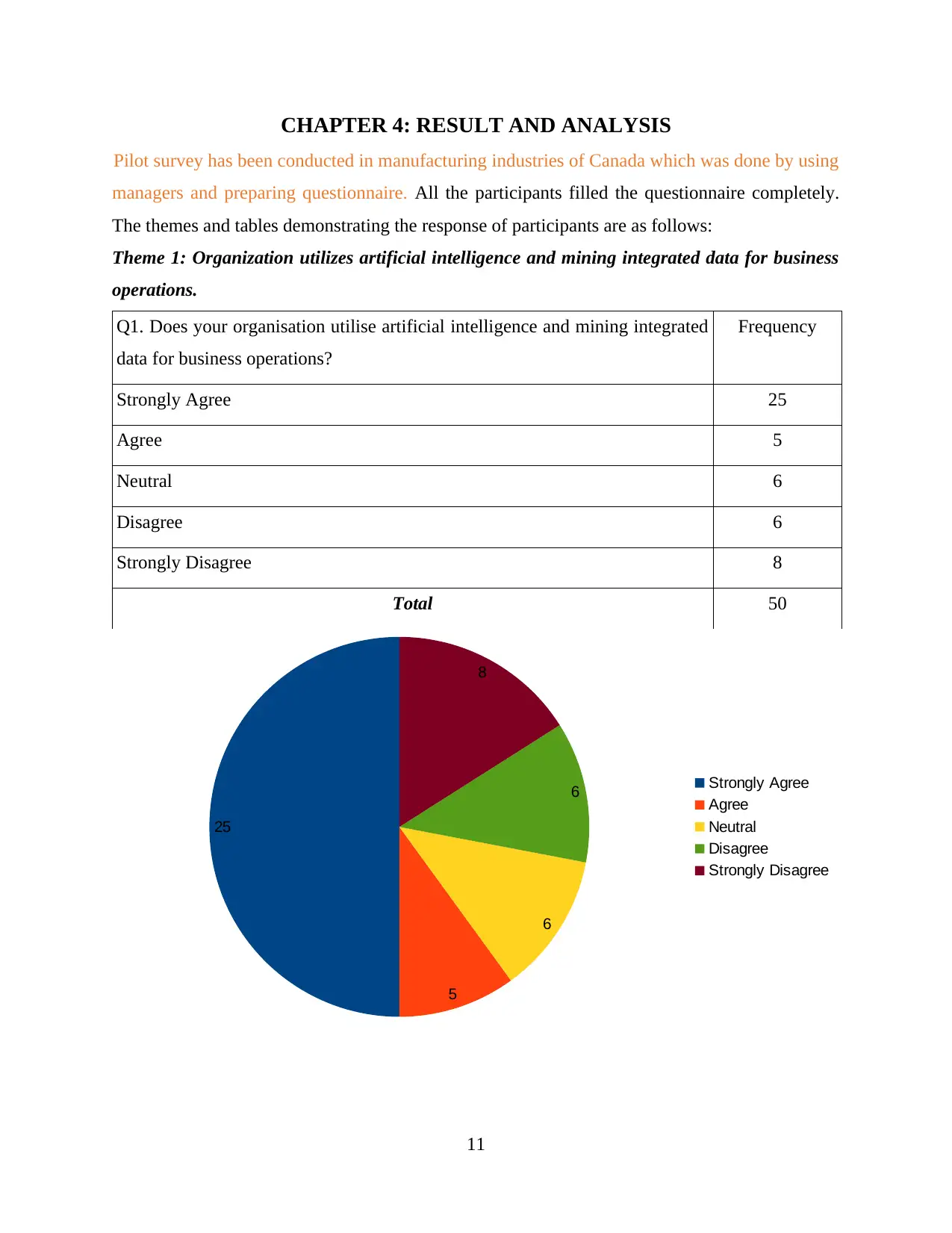
CHAPTER 4: RESULT AND ANALYSIS
Pilot survey has been conducted in manufacturing industries of Canada which was done by using
managers and preparing questionnaire. All the participants filled the questionnaire completely.
The themes and tables demonstrating the response of participants are as follows:
Theme 1: Organization utilizes artificial intelligence and mining integrated data for business
operations.
Q1. Does your organisation utilise artificial intelligence and mining integrated
data for business operations?
Frequency
Strongly Agree 25
Agree 5
Neutral 6
Disagree 6
Strongly Disagree 8
Total 50
11
25
5
6
6
8
Strongly Agree
Agree
Neutral
Disagree
Strongly Disagree
Pilot survey has been conducted in manufacturing industries of Canada which was done by using
managers and preparing questionnaire. All the participants filled the questionnaire completely.
The themes and tables demonstrating the response of participants are as follows:
Theme 1: Organization utilizes artificial intelligence and mining integrated data for business
operations.
Q1. Does your organisation utilise artificial intelligence and mining integrated
data for business operations?
Frequency
Strongly Agree 25
Agree 5
Neutral 6
Disagree 6
Strongly Disagree 8
Total 50
11
25
5
6
6
8
Strongly Agree
Agree
Neutral
Disagree
Strongly Disagree
Paraphrase This Document
Need a fresh take? Get an instant paraphrase of this document with our AI Paraphraser
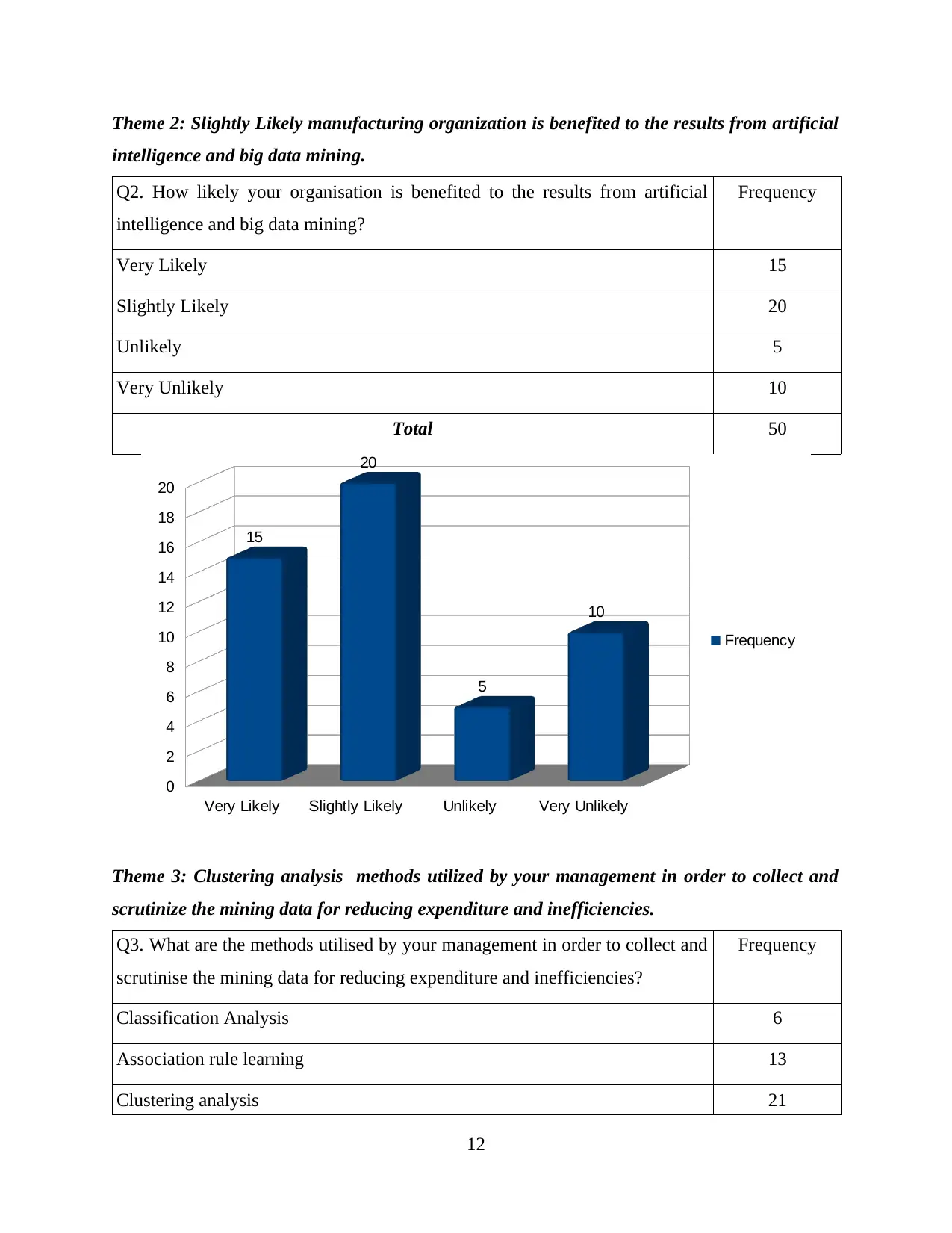
Theme 2: Slightly Likely manufacturing organization is benefited to the results from artificial
intelligence and big data mining.
Q2. How likely your organisation is benefited to the results from artificial
intelligence and big data mining?
Frequency
Very Likely 15
Slightly Likely 20
Unlikely 5
Very Unlikely 10
Total 50
Theme 3: Clustering analysis methods utilized by your management in order to collect and
scrutinize the mining data for reducing expenditure and inefficiencies.
Q3. What are the methods utilised by your management in order to collect and
scrutinise the mining data for reducing expenditure and inefficiencies?
Frequency
Classification Analysis 6
Association rule learning 13
Clustering analysis 21
12
Very Likely Slightly Likely Unlikely Very Unlikely
0
2
4
6
8
10
12
14
16
18
20
15
20
5
10
Frequency
intelligence and big data mining.
Q2. How likely your organisation is benefited to the results from artificial
intelligence and big data mining?
Frequency
Very Likely 15
Slightly Likely 20
Unlikely 5
Very Unlikely 10
Total 50
Theme 3: Clustering analysis methods utilized by your management in order to collect and
scrutinize the mining data for reducing expenditure and inefficiencies.
Q3. What are the methods utilised by your management in order to collect and
scrutinise the mining data for reducing expenditure and inefficiencies?
Frequency
Classification Analysis 6
Association rule learning 13
Clustering analysis 21
12
Very Likely Slightly Likely Unlikely Very Unlikely
0
2
4
6
8
10
12
14
16
18
20
15
20
5
10
Frequency
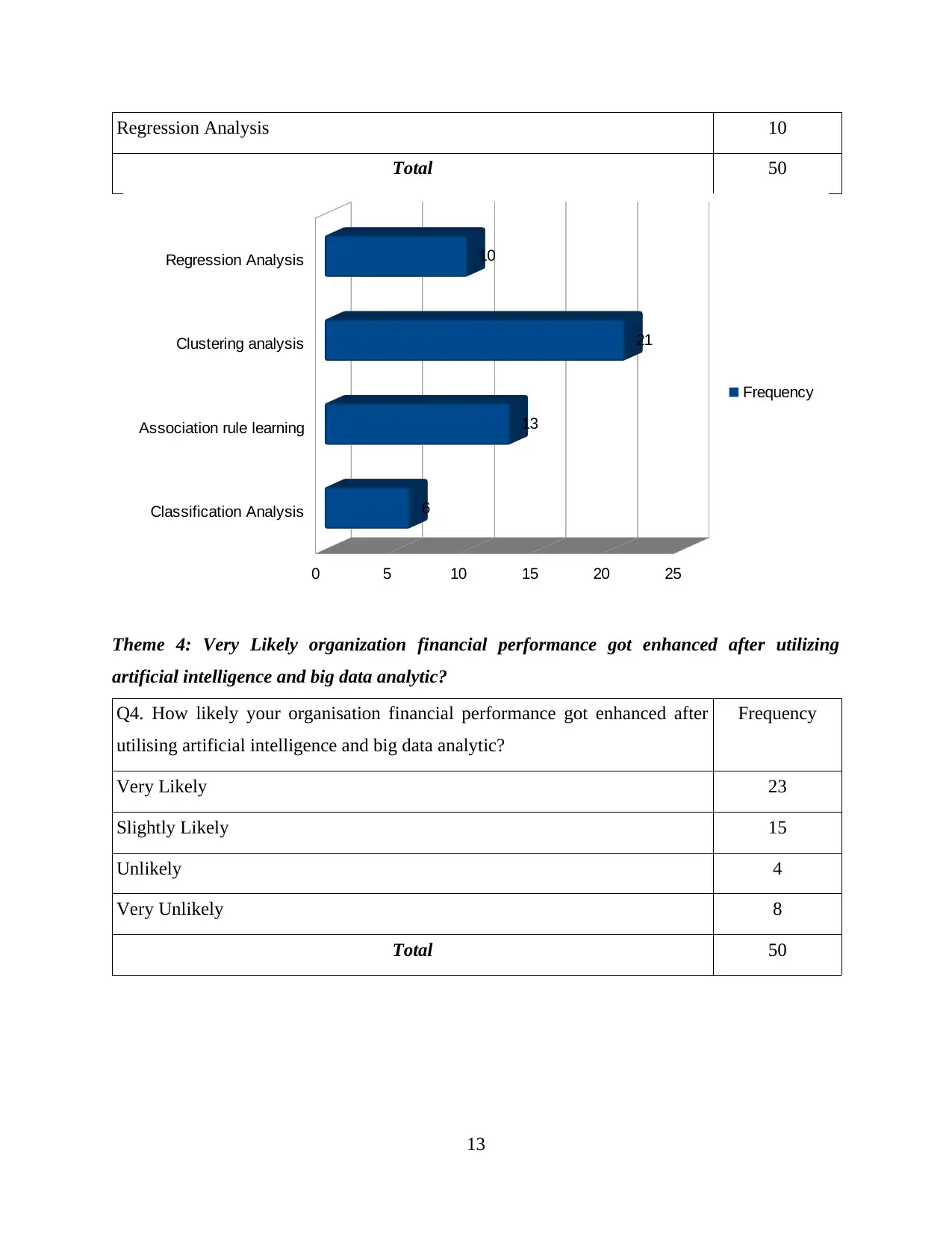
Regression Analysis 10
Total 50
Theme 4: Very Likely organization financial performance got enhanced after utilizing
artificial intelligence and big data analytic?
Q4. How likely your organisation financial performance got enhanced after
utilising artificial intelligence and big data analytic?
Frequency
Very Likely 23
Slightly Likely 15
Unlikely 4
Very Unlikely 8
Total 50
13
Classification Analysis
Association rule learning
Clustering analysis
Regression Analysis
0 5 10 15 20 25
6
13
21
10
Frequency
Total 50
Theme 4: Very Likely organization financial performance got enhanced after utilizing
artificial intelligence and big data analytic?
Q4. How likely your organisation financial performance got enhanced after
utilising artificial intelligence and big data analytic?
Frequency
Very Likely 23
Slightly Likely 15
Unlikely 4
Very Unlikely 8
Total 50
13
Classification Analysis
Association rule learning
Clustering analysis
Regression Analysis
0 5 10 15 20 25
6
13
21
10
Frequency
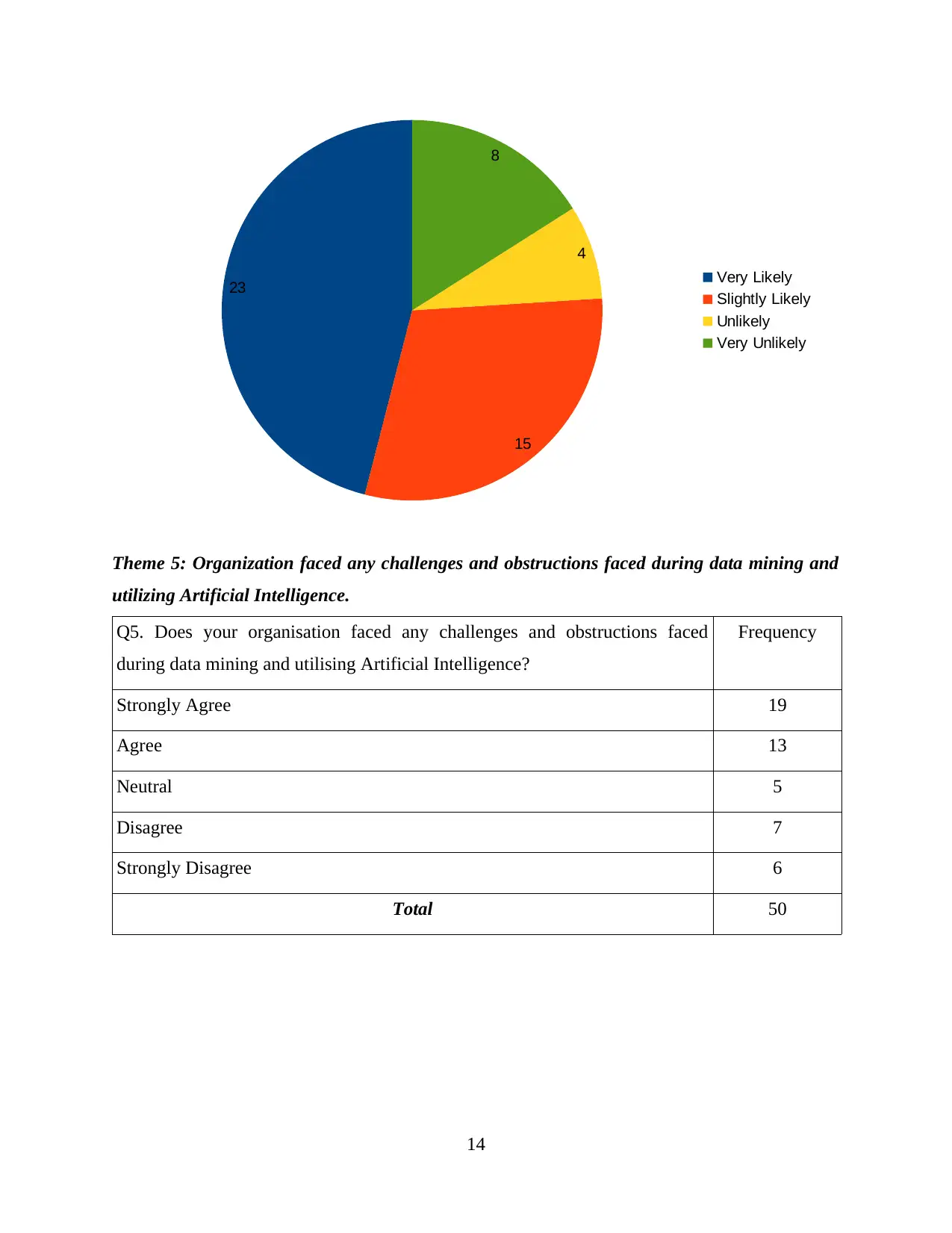
Theme 5: Organization faced any challenges and obstructions faced during data mining and
utilizing Artificial Intelligence.
Q5. Does your organisation faced any challenges and obstructions faced
during data mining and utilising Artificial Intelligence?
Frequency
Strongly Agree 19
Agree 13
Neutral 5
Disagree 7
Strongly Disagree 6
Total 50
14
23
15
4
8
Very Likely
Slightly Likely
Unlikely
Very Unlikely
utilizing Artificial Intelligence.
Q5. Does your organisation faced any challenges and obstructions faced
during data mining and utilising Artificial Intelligence?
Frequency
Strongly Agree 19
Agree 13
Neutral 5
Disagree 7
Strongly Disagree 6
Total 50
14
23
15
4
8
Very Likely
Slightly Likely
Unlikely
Very Unlikely
Secure Best Marks with AI Grader
Need help grading? Try our AI Grader for instant feedback on your assignments.
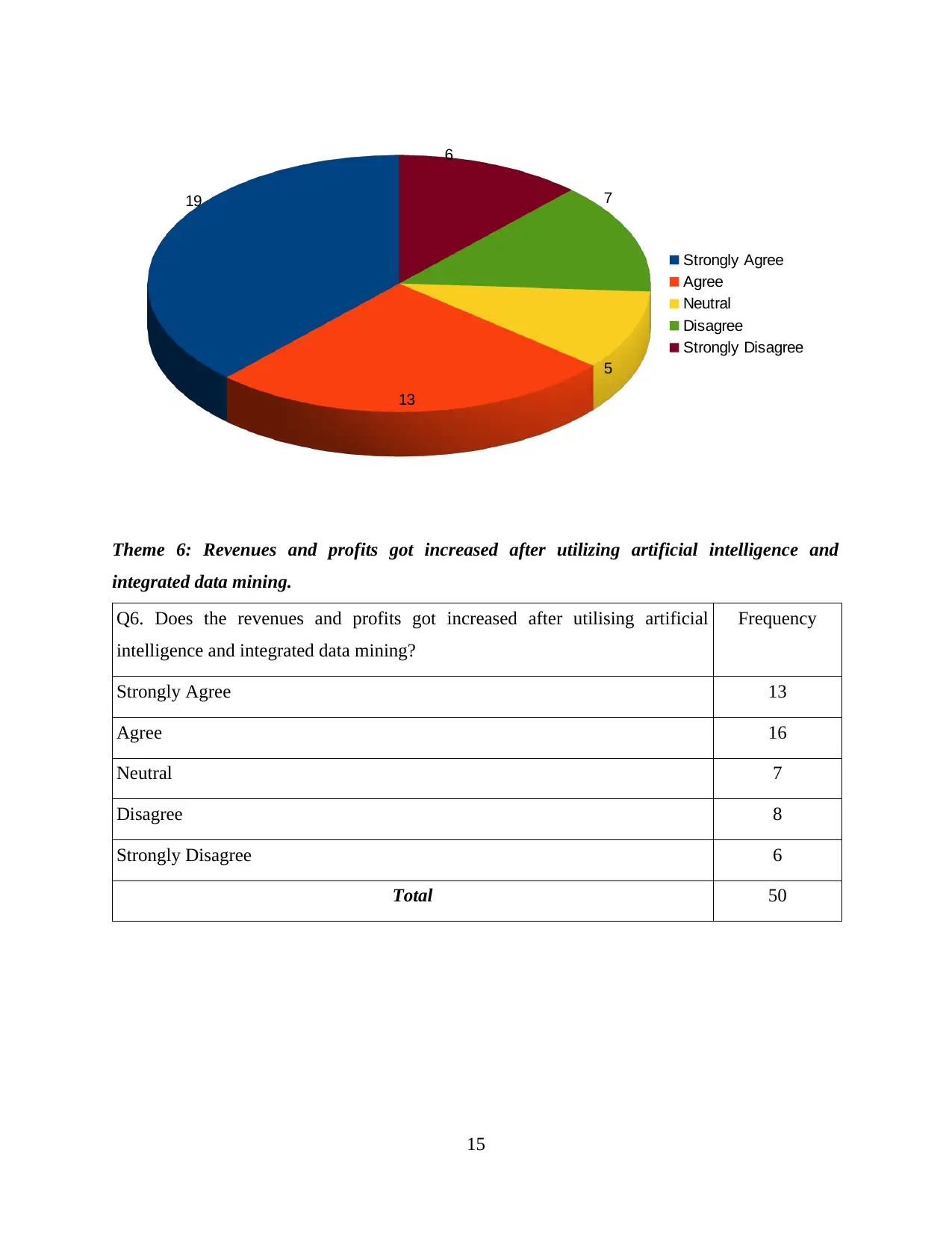
Theme 6: Revenues and profits got increased after utilizing artificial intelligence and
integrated data mining.
Q6. Does the revenues and profits got increased after utilising artificial
intelligence and integrated data mining?
Frequency
Strongly Agree 13
Agree 16
Neutral 7
Disagree 8
Strongly Disagree 6
Total 50
15
19
13
5
7
6
Strongly Agree
Agree
Neutral
Disagree
Strongly Disagree
integrated data mining.
Q6. Does the revenues and profits got increased after utilising artificial
intelligence and integrated data mining?
Frequency
Strongly Agree 13
Agree 16
Neutral 7
Disagree 8
Strongly Disagree 6
Total 50
15
19
13
5
7
6
Strongly Agree
Agree
Neutral
Disagree
Strongly Disagree
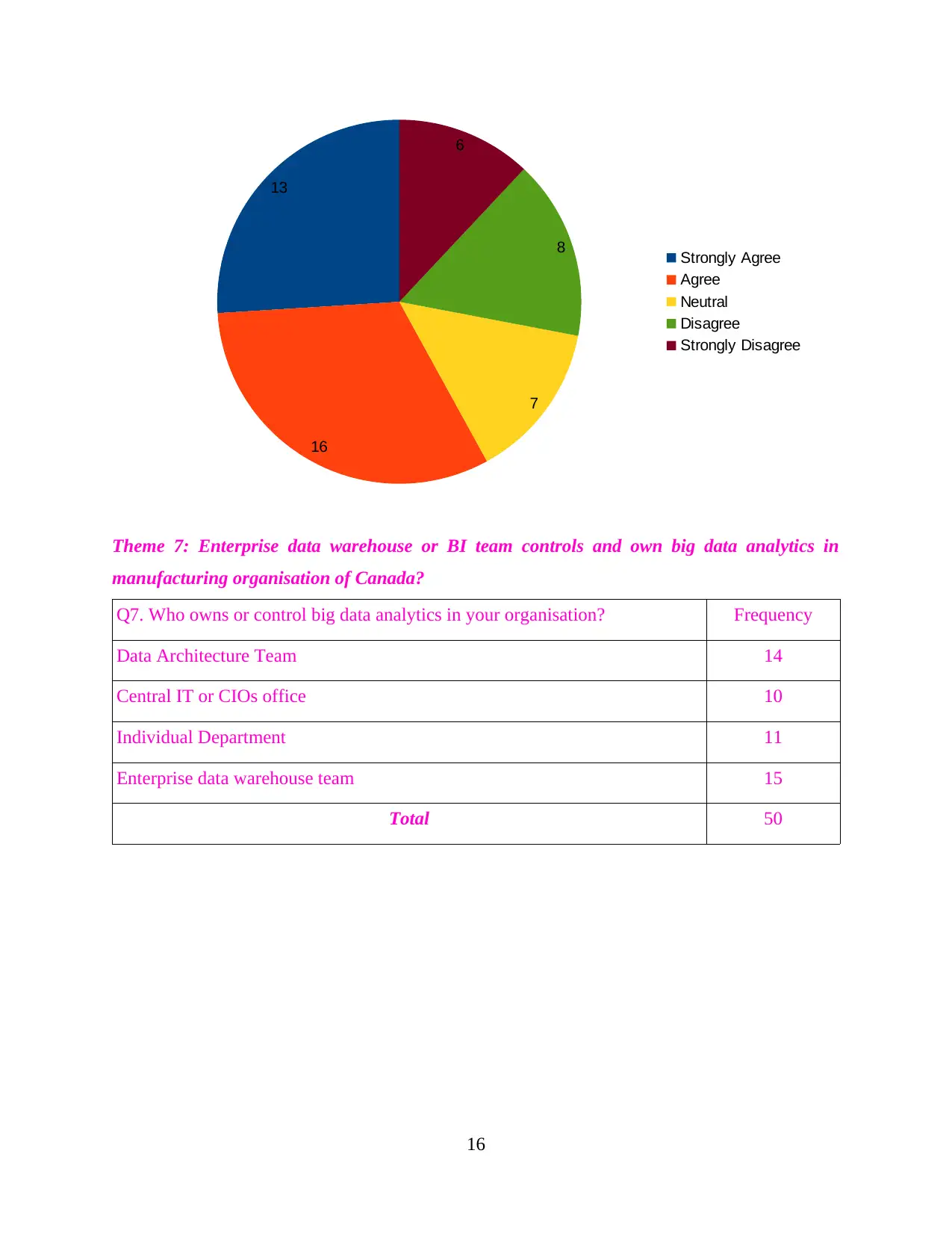
Theme 7: Enterprise data warehouse or BI team controls and own big data analytics in
manufacturing organisation of Canada?
Q7. Who owns or control big data analytics in your organisation? Frequency
Data Architecture Team 14
Central IT or CIOs office 10
Individual Department 11
Enterprise data warehouse team 15
Total 50
16
13
16
7
8
6
Strongly Agree
Agree
Neutral
Disagree
Strongly Disagree
manufacturing organisation of Canada?
Q7. Who owns or control big data analytics in your organisation? Frequency
Data Architecture Team 14
Central IT or CIOs office 10
Individual Department 11
Enterprise data warehouse team 15
Total 50
16
13
16
7
8
6
Strongly Agree
Agree
Neutral
Disagree
Strongly Disagree
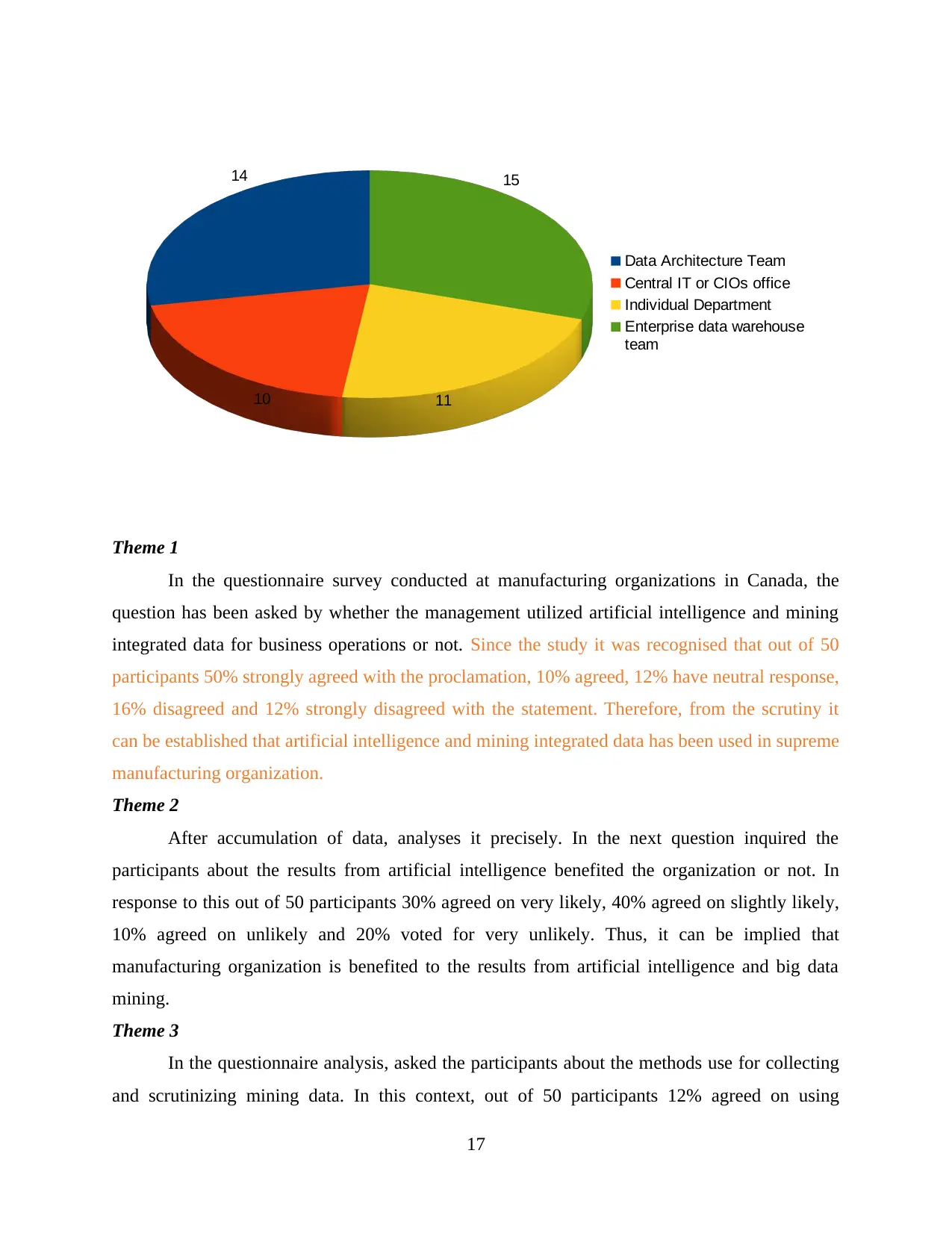
Theme 1
In the questionnaire survey conducted at manufacturing organizations in Canada, the
question has been asked by whether the management utilized artificial intelligence and mining
integrated data for business operations or not. Since the study it was recognised that out of 50
participants 50% strongly agreed with the proclamation, 10% agreed, 12% have neutral response,
16% disagreed and 12% strongly disagreed with the statement. Therefore, from the scrutiny it
can be established that artificial intelligence and mining integrated data has been used in supreme
manufacturing organization.
Theme 2
After accumulation of data, analyses it precisely. In the next question inquired the
participants about the results from artificial intelligence benefited the organization or not. In
response to this out of 50 participants 30% agreed on very likely, 40% agreed on slightly likely,
10% agreed on unlikely and 20% voted for very unlikely. Thus, it can be implied that
manufacturing organization is benefited to the results from artificial intelligence and big data
mining.
Theme 3
In the questionnaire analysis, asked the participants about the methods use for collecting
and scrutinizing mining data. In this context, out of 50 participants 12% agreed on using
17
14
10 11
15
Data Architecture Team
Central IT or CIOs office
Individual Department
Enterprise data warehouse
team
In the questionnaire survey conducted at manufacturing organizations in Canada, the
question has been asked by whether the management utilized artificial intelligence and mining
integrated data for business operations or not. Since the study it was recognised that out of 50
participants 50% strongly agreed with the proclamation, 10% agreed, 12% have neutral response,
16% disagreed and 12% strongly disagreed with the statement. Therefore, from the scrutiny it
can be established that artificial intelligence and mining integrated data has been used in supreme
manufacturing organization.
Theme 2
After accumulation of data, analyses it precisely. In the next question inquired the
participants about the results from artificial intelligence benefited the organization or not. In
response to this out of 50 participants 30% agreed on very likely, 40% agreed on slightly likely,
10% agreed on unlikely and 20% voted for very unlikely. Thus, it can be implied that
manufacturing organization is benefited to the results from artificial intelligence and big data
mining.
Theme 3
In the questionnaire analysis, asked the participants about the methods use for collecting
and scrutinizing mining data. In this context, out of 50 participants 12% agreed on using
17
14
10 11
15
Data Architecture Team
Central IT or CIOs office
Individual Department
Enterprise data warehouse
team
Paraphrase This Document
Need a fresh take? Get an instant paraphrase of this document with our AI Paraphraser
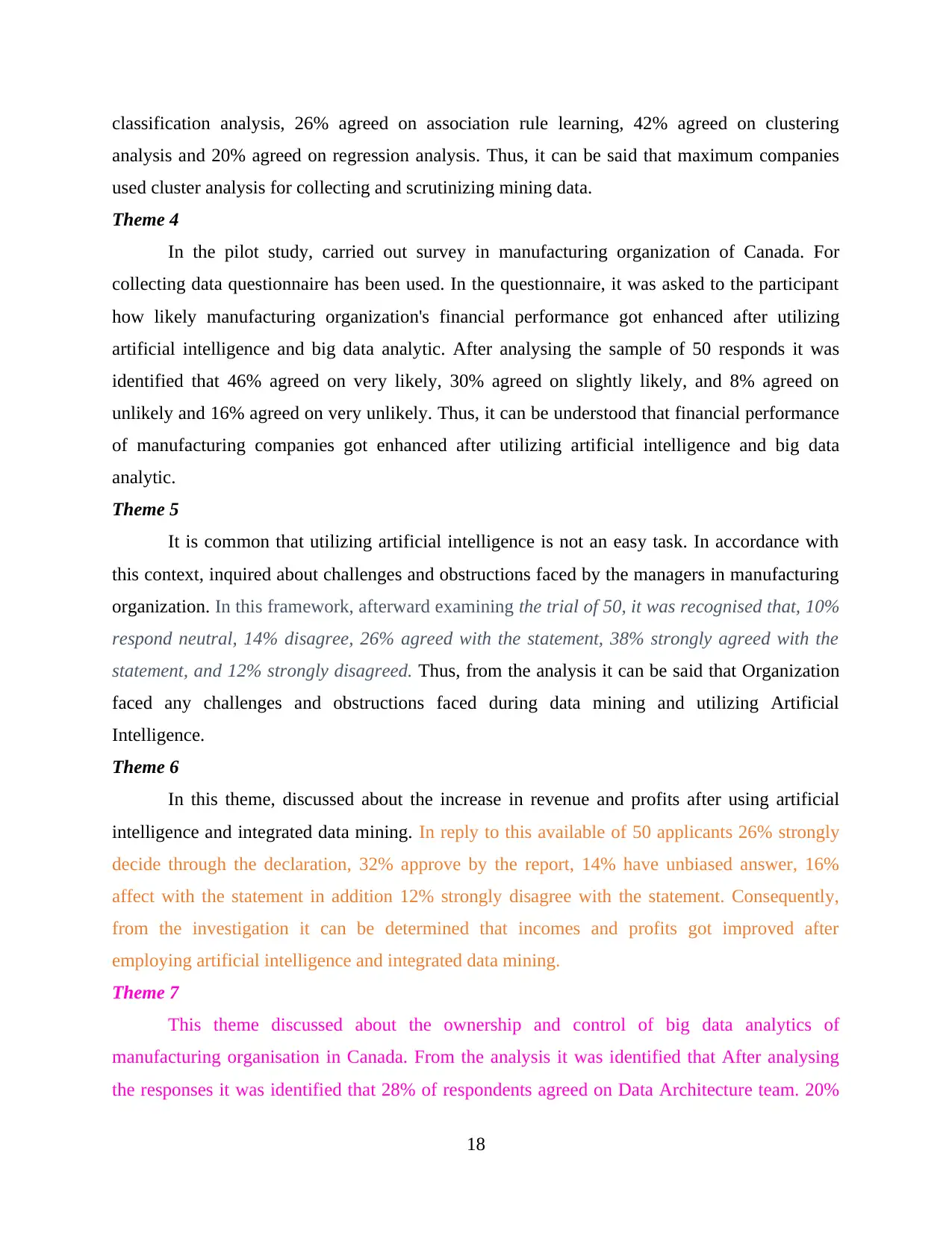
classification analysis, 26% agreed on association rule learning, 42% agreed on clustering
analysis and 20% agreed on regression analysis. Thus, it can be said that maximum companies
used cluster analysis for collecting and scrutinizing mining data.
Theme 4
In the pilot study, carried out survey in manufacturing organization of Canada. For
collecting data questionnaire has been used. In the questionnaire, it was asked to the participant
how likely manufacturing organization's financial performance got enhanced after utilizing
artificial intelligence and big data analytic. After analysing the sample of 50 responds it was
identified that 46% agreed on very likely, 30% agreed on slightly likely, and 8% agreed on
unlikely and 16% agreed on very unlikely. Thus, it can be understood that financial performance
of manufacturing companies got enhanced after utilizing artificial intelligence and big data
analytic.
Theme 5
It is common that utilizing artificial intelligence is not an easy task. In accordance with
this context, inquired about challenges and obstructions faced by the managers in manufacturing
organization. In this framework, afterward examining the trial of 50, it was recognised that, 10%
respond neutral, 14% disagree, 26% agreed with the statement, 38% strongly agreed with the
statement, and 12% strongly disagreed. Thus, from the analysis it can be said that Organization
faced any challenges and obstructions faced during data mining and utilizing Artificial
Intelligence.
Theme 6
In this theme, discussed about the increase in revenue and profits after using artificial
intelligence and integrated data mining. In reply to this available of 50 applicants 26% strongly
decide through the declaration, 32% approve by the report, 14% have unbiased answer, 16%
affect with the statement in addition 12% strongly disagree with the statement. Consequently,
from the investigation it can be determined that incomes and profits got improved after
employing artificial intelligence and integrated data mining.
Theme 7
This theme discussed about the ownership and control of big data analytics of
manufacturing organisation in Canada. From the analysis it was identified that After analysing
the responses it was identified that 28% of respondents agreed on Data Architecture team. 20%
18
analysis and 20% agreed on regression analysis. Thus, it can be said that maximum companies
used cluster analysis for collecting and scrutinizing mining data.
Theme 4
In the pilot study, carried out survey in manufacturing organization of Canada. For
collecting data questionnaire has been used. In the questionnaire, it was asked to the participant
how likely manufacturing organization's financial performance got enhanced after utilizing
artificial intelligence and big data analytic. After analysing the sample of 50 responds it was
identified that 46% agreed on very likely, 30% agreed on slightly likely, and 8% agreed on
unlikely and 16% agreed on very unlikely. Thus, it can be understood that financial performance
of manufacturing companies got enhanced after utilizing artificial intelligence and big data
analytic.
Theme 5
It is common that utilizing artificial intelligence is not an easy task. In accordance with
this context, inquired about challenges and obstructions faced by the managers in manufacturing
organization. In this framework, afterward examining the trial of 50, it was recognised that, 10%
respond neutral, 14% disagree, 26% agreed with the statement, 38% strongly agreed with the
statement, and 12% strongly disagreed. Thus, from the analysis it can be said that Organization
faced any challenges and obstructions faced during data mining and utilizing Artificial
Intelligence.
Theme 6
In this theme, discussed about the increase in revenue and profits after using artificial
intelligence and integrated data mining. In reply to this available of 50 applicants 26% strongly
decide through the declaration, 32% approve by the report, 14% have unbiased answer, 16%
affect with the statement in addition 12% strongly disagree with the statement. Consequently,
from the investigation it can be determined that incomes and profits got improved after
employing artificial intelligence and integrated data mining.
Theme 7
This theme discussed about the ownership and control of big data analytics of
manufacturing organisation in Canada. From the analysis it was identified that After analysing
the responses it was identified that 28% of respondents agreed on Data Architecture team. 20%
18

of participants agreed on Central IT or CIOs office. 22% of participants agreed on individual
department and 30% of participant agreed on enterprise data warehouse of BI Team. Big Data
analytics has been owned and controlled by Enterprise data warehouse or BI teams.
19
department and 30% of participant agreed on enterprise data warehouse of BI Team. Big Data
analytics has been owned and controlled by Enterprise data warehouse or BI teams.
19
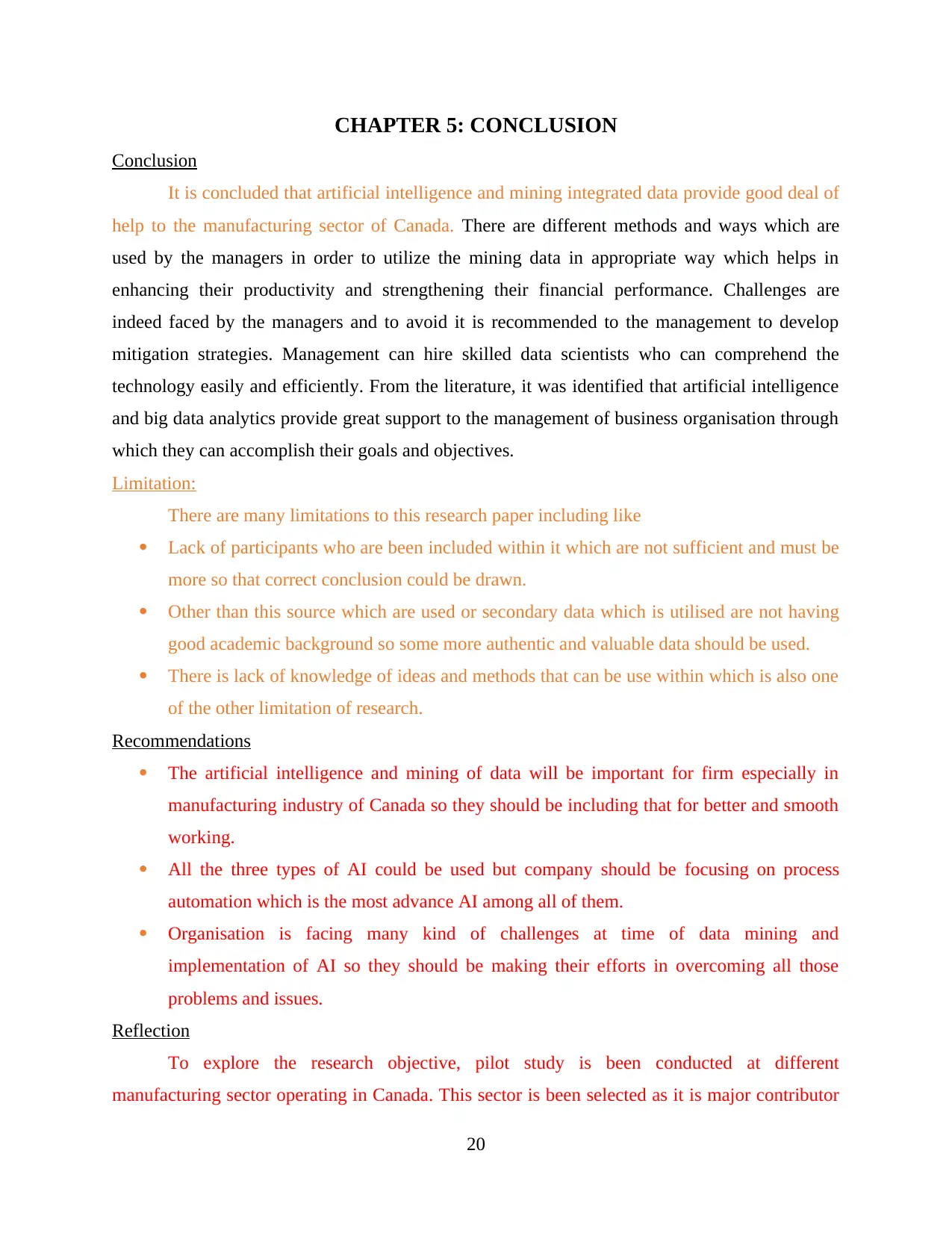
CHAPTER 5: CONCLUSION
Conclusion
It is concluded that artificial intelligence and mining integrated data provide good deal of
help to the manufacturing sector of Canada. There are different methods and ways which are
used by the managers in order to utilize the mining data in appropriate way which helps in
enhancing their productivity and strengthening their financial performance. Challenges are
indeed faced by the managers and to avoid it is recommended to the management to develop
mitigation strategies. Management can hire skilled data scientists who can comprehend the
technology easily and efficiently. From the literature, it was identified that artificial intelligence
and big data analytics provide great support to the management of business organisation through
which they can accomplish their goals and objectives.
Limitation:
There are many limitations to this research paper including like
Lack of participants who are been included within it which are not sufficient and must be
more so that correct conclusion could be drawn.
Other than this source which are used or secondary data which is utilised are not having
good academic background so some more authentic and valuable data should be used.
There is lack of knowledge of ideas and methods that can be use within which is also one
of the other limitation of research.
Recommendations
The artificial intelligence and mining of data will be important for firm especially in
manufacturing industry of Canada so they should be including that for better and smooth
working.
All the three types of AI could be used but company should be focusing on process
automation which is the most advance AI among all of them.
Organisation is facing many kind of challenges at time of data mining and
implementation of AI so they should be making their efforts in overcoming all those
problems and issues.
Reflection
To explore the research objective, pilot study is been conducted at different
manufacturing sector operating in Canada. This sector is been selected as it is major contributor
20
Conclusion
It is concluded that artificial intelligence and mining integrated data provide good deal of
help to the manufacturing sector of Canada. There are different methods and ways which are
used by the managers in order to utilize the mining data in appropriate way which helps in
enhancing their productivity and strengthening their financial performance. Challenges are
indeed faced by the managers and to avoid it is recommended to the management to develop
mitigation strategies. Management can hire skilled data scientists who can comprehend the
technology easily and efficiently. From the literature, it was identified that artificial intelligence
and big data analytics provide great support to the management of business organisation through
which they can accomplish their goals and objectives.
Limitation:
There are many limitations to this research paper including like
Lack of participants who are been included within it which are not sufficient and must be
more so that correct conclusion could be drawn.
Other than this source which are used or secondary data which is utilised are not having
good academic background so some more authentic and valuable data should be used.
There is lack of knowledge of ideas and methods that can be use within which is also one
of the other limitation of research.
Recommendations
The artificial intelligence and mining of data will be important for firm especially in
manufacturing industry of Canada so they should be including that for better and smooth
working.
All the three types of AI could be used but company should be focusing on process
automation which is the most advance AI among all of them.
Organisation is facing many kind of challenges at time of data mining and
implementation of AI so they should be making their efforts in overcoming all those
problems and issues.
Reflection
To explore the research objective, pilot study is been conducted at different
manufacturing sector operating in Canada. This sector is been selected as it is major contributor
20
Secure Best Marks with AI Grader
Need help grading? Try our AI Grader for instant feedback on your assignments.
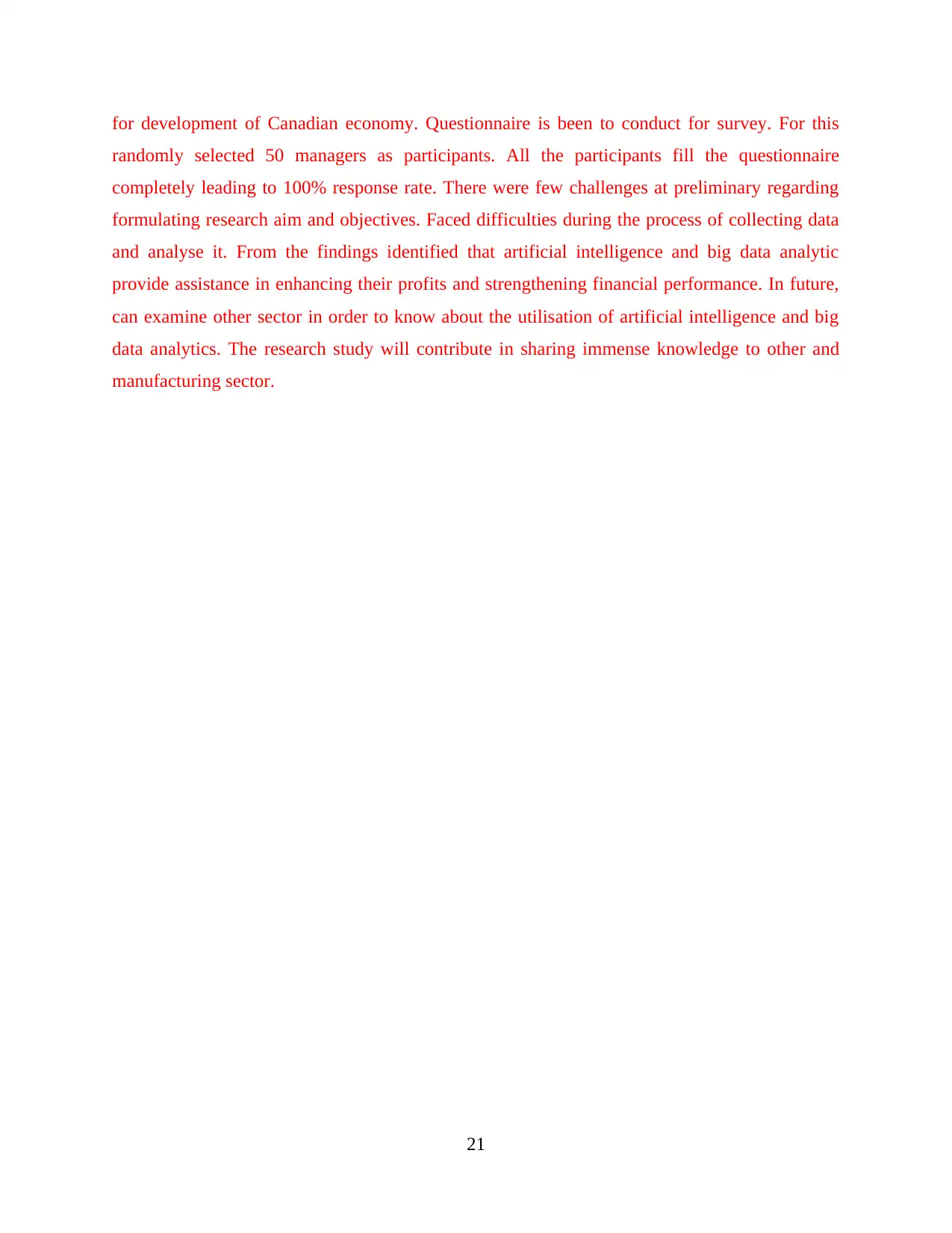
for development of Canadian economy. Questionnaire is been to conduct for survey. For this
randomly selected 50 managers as participants. All the participants fill the questionnaire
completely leading to 100% response rate. There were few challenges at preliminary regarding
formulating research aim and objectives. Faced difficulties during the process of collecting data
and analyse it. From the findings identified that artificial intelligence and big data analytic
provide assistance in enhancing their profits and strengthening financial performance. In future,
can examine other sector in order to know about the utilisation of artificial intelligence and big
data analytics. The research study will contribute in sharing immense knowledge to other and
manufacturing sector.
21
randomly selected 50 managers as participants. All the participants fill the questionnaire
completely leading to 100% response rate. There were few challenges at preliminary regarding
formulating research aim and objectives. Faced difficulties during the process of collecting data
and analyse it. From the findings identified that artificial intelligence and big data analytic
provide assistance in enhancing their profits and strengthening financial performance. In future,
can examine other sector in order to know about the utilisation of artificial intelligence and big
data analytics. The research study will contribute in sharing immense knowledge to other and
manufacturing sector.
21
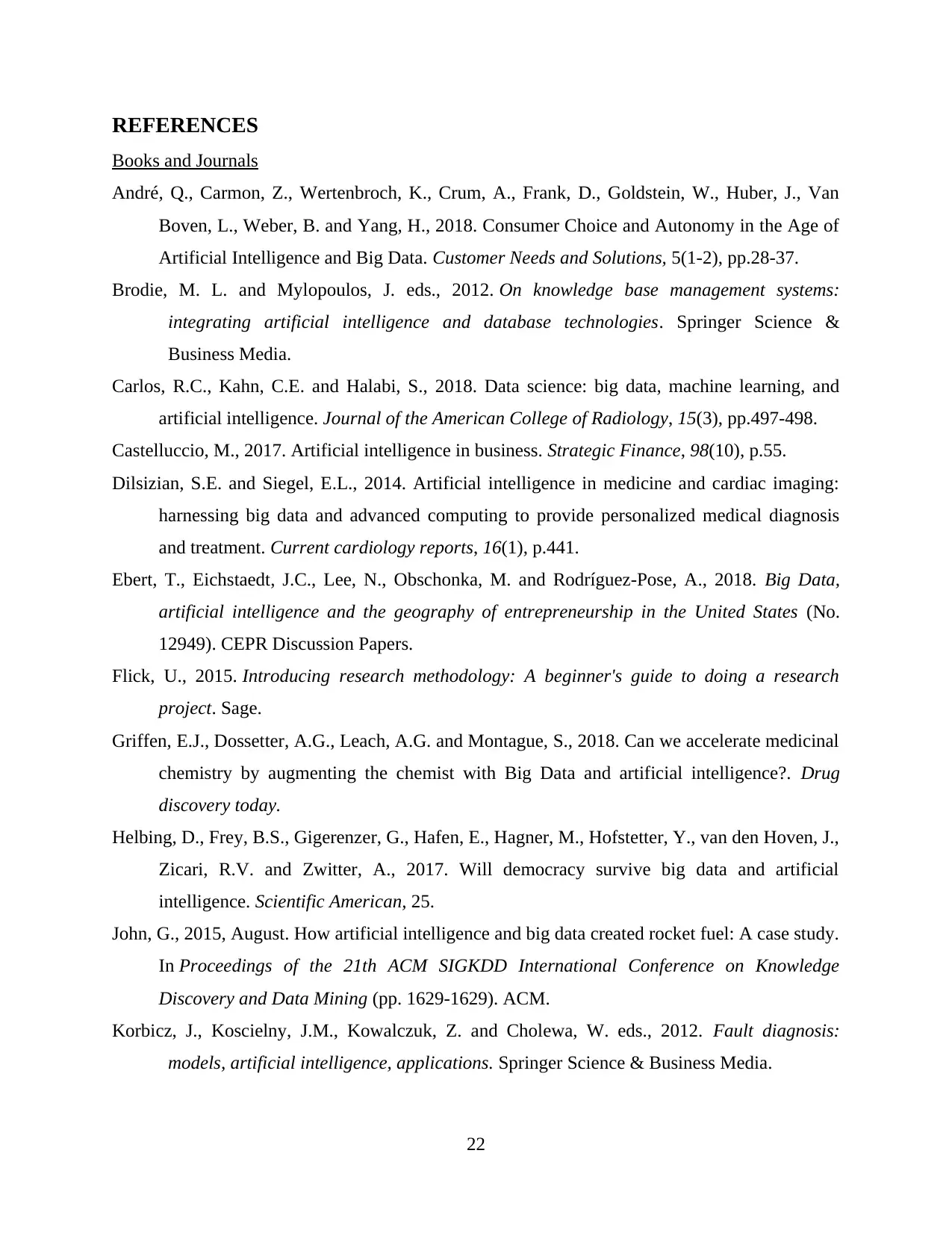
REFERENCES
Books and Journals
André, Q., Carmon, Z., Wertenbroch, K., Crum, A., Frank, D., Goldstein, W., Huber, J., Van
Boven, L., Weber, B. and Yang, H., 2018. Consumer Choice and Autonomy in the Age of
Artificial Intelligence and Big Data. Customer Needs and Solutions, 5(1-2), pp.28-37.
Brodie, M. L. and Mylopoulos, J. eds., 2012. On knowledge base management systems:
integrating artificial intelligence and database technologies. Springer Science &
Business Media.
Carlos, R.C., Kahn, C.E. and Halabi, S., 2018. Data science: big data, machine learning, and
artificial intelligence. Journal of the American College of Radiology, 15(3), pp.497-498.
Castelluccio, M., 2017. Artificial intelligence in business. Strategic Finance, 98(10), p.55.
Dilsizian, S.E. and Siegel, E.L., 2014. Artificial intelligence in medicine and cardiac imaging:
harnessing big data and advanced computing to provide personalized medical diagnosis
and treatment. Current cardiology reports, 16(1), p.441.
Ebert, T., Eichstaedt, J.C., Lee, N., Obschonka, M. and Rodríguez-Pose, A., 2018. Big Data,
artificial intelligence and the geography of entrepreneurship in the United States (No.
12949). CEPR Discussion Papers.
Flick, U., 2015. Introducing research methodology: A beginner's guide to doing a research
project. Sage.
Griffen, E.J., Dossetter, A.G., Leach, A.G. and Montague, S., 2018. Can we accelerate medicinal
chemistry by augmenting the chemist with Big Data and artificial intelligence?. Drug
discovery today.
Helbing, D., Frey, B.S., Gigerenzer, G., Hafen, E., Hagner, M., Hofstetter, Y., van den Hoven, J.,
Zicari, R.V. and Zwitter, A., 2017. Will democracy survive big data and artificial
intelligence. Scientific American, 25.
John, G., 2015, August. How artificial intelligence and big data created rocket fuel: A case study.
In Proceedings of the 21th ACM SIGKDD International Conference on Knowledge
Discovery and Data Mining (pp. 1629-1629). ACM.
Korbicz, J., Koscielny, J.M., Kowalczuk, Z. and Cholewa, W. eds., 2012. Fault diagnosis:
models, artificial intelligence, applications. Springer Science & Business Media.
22
Books and Journals
André, Q., Carmon, Z., Wertenbroch, K., Crum, A., Frank, D., Goldstein, W., Huber, J., Van
Boven, L., Weber, B. and Yang, H., 2018. Consumer Choice and Autonomy in the Age of
Artificial Intelligence and Big Data. Customer Needs and Solutions, 5(1-2), pp.28-37.
Brodie, M. L. and Mylopoulos, J. eds., 2012. On knowledge base management systems:
integrating artificial intelligence and database technologies. Springer Science &
Business Media.
Carlos, R.C., Kahn, C.E. and Halabi, S., 2018. Data science: big data, machine learning, and
artificial intelligence. Journal of the American College of Radiology, 15(3), pp.497-498.
Castelluccio, M., 2017. Artificial intelligence in business. Strategic Finance, 98(10), p.55.
Dilsizian, S.E. and Siegel, E.L., 2014. Artificial intelligence in medicine and cardiac imaging:
harnessing big data and advanced computing to provide personalized medical diagnosis
and treatment. Current cardiology reports, 16(1), p.441.
Ebert, T., Eichstaedt, J.C., Lee, N., Obschonka, M. and Rodríguez-Pose, A., 2018. Big Data,
artificial intelligence and the geography of entrepreneurship in the United States (No.
12949). CEPR Discussion Papers.
Flick, U., 2015. Introducing research methodology: A beginner's guide to doing a research
project. Sage.
Griffen, E.J., Dossetter, A.G., Leach, A.G. and Montague, S., 2018. Can we accelerate medicinal
chemistry by augmenting the chemist with Big Data and artificial intelligence?. Drug
discovery today.
Helbing, D., Frey, B.S., Gigerenzer, G., Hafen, E., Hagner, M., Hofstetter, Y., van den Hoven, J.,
Zicari, R.V. and Zwitter, A., 2017. Will democracy survive big data and artificial
intelligence. Scientific American, 25.
John, G., 2015, August. How artificial intelligence and big data created rocket fuel: A case study.
In Proceedings of the 21th ACM SIGKDD International Conference on Knowledge
Discovery and Data Mining (pp. 1629-1629). ACM.
Korbicz, J., Koscielny, J.M., Kowalczuk, Z. and Cholewa, W. eds., 2012. Fault diagnosis:
models, artificial intelligence, applications. Springer Science & Business Media.
22
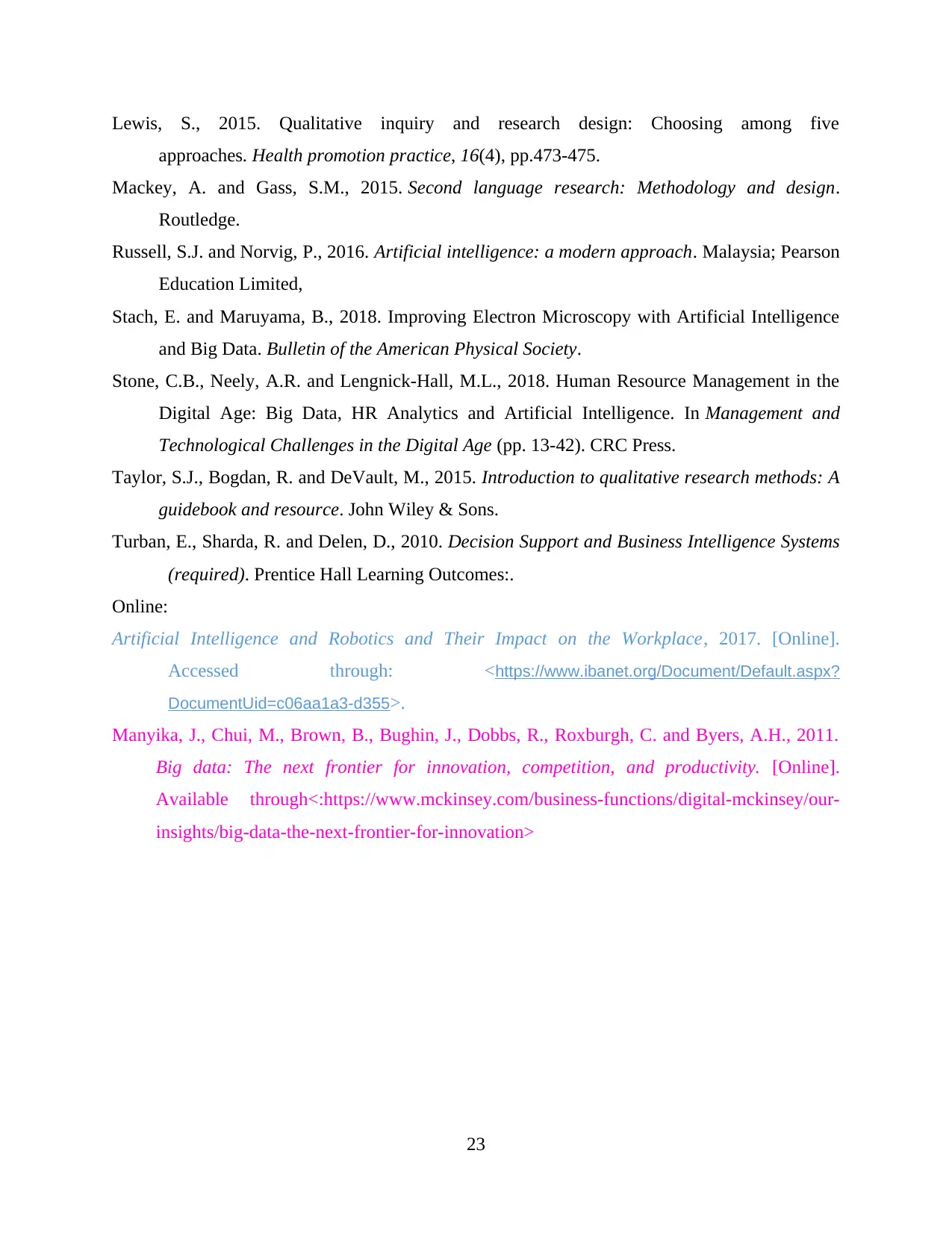
Lewis, S., 2015. Qualitative inquiry and research design: Choosing among five
approaches. Health promotion practice, 16(4), pp.473-475.
Mackey, A. and Gass, S.M., 2015. Second language research: Methodology and design.
Routledge.
Russell, S.J. and Norvig, P., 2016. Artificial intelligence: a modern approach. Malaysia; Pearson
Education Limited,
Stach, E. and Maruyama, B., 2018. Improving Electron Microscopy with Artificial Intelligence
and Big Data. Bulletin of the American Physical Society.
Stone, C.B., Neely, A.R. and Lengnick-Hall, M.L., 2018. Human Resource Management in the
Digital Age: Big Data, HR Analytics and Artificial Intelligence. In Management and
Technological Challenges in the Digital Age (pp. 13-42). CRC Press.
Taylor, S.J., Bogdan, R. and DeVault, M., 2015. Introduction to qualitative research methods: A
guidebook and resource. John Wiley & Sons.
Turban, E., Sharda, R. and Delen, D., 2010. Decision Support and Business Intelligence Systems
(required). Prentice Hall Learning Outcomes:.
Online:
Artificial Intelligence and Robotics and Their Impact on the Workplace, 2017. [Online].
Accessed through: <https://www.ibanet.org/Document/Default.aspx?
DocumentUid=c06aa1a3-d355>.
Manyika, J., Chui, M., Brown, B., Bughin, J., Dobbs, R., Roxburgh, C. and Byers, A.H., 2011.
Big data: The next frontier for innovation, competition, and productivity. [Online].
Available through<:https://www.mckinsey.com/business-functions/digital-mckinsey/our-
insights/big-data-the-next-frontier-for-innovation>
23
approaches. Health promotion practice, 16(4), pp.473-475.
Mackey, A. and Gass, S.M., 2015. Second language research: Methodology and design.
Routledge.
Russell, S.J. and Norvig, P., 2016. Artificial intelligence: a modern approach. Malaysia; Pearson
Education Limited,
Stach, E. and Maruyama, B., 2018. Improving Electron Microscopy with Artificial Intelligence
and Big Data. Bulletin of the American Physical Society.
Stone, C.B., Neely, A.R. and Lengnick-Hall, M.L., 2018. Human Resource Management in the
Digital Age: Big Data, HR Analytics and Artificial Intelligence. In Management and
Technological Challenges in the Digital Age (pp. 13-42). CRC Press.
Taylor, S.J., Bogdan, R. and DeVault, M., 2015. Introduction to qualitative research methods: A
guidebook and resource. John Wiley & Sons.
Turban, E., Sharda, R. and Delen, D., 2010. Decision Support and Business Intelligence Systems
(required). Prentice Hall Learning Outcomes:.
Online:
Artificial Intelligence and Robotics and Their Impact on the Workplace, 2017. [Online].
Accessed through: <https://www.ibanet.org/Document/Default.aspx?
DocumentUid=c06aa1a3-d355>.
Manyika, J., Chui, M., Brown, B., Bughin, J., Dobbs, R., Roxburgh, C. and Byers, A.H., 2011.
Big data: The next frontier for innovation, competition, and productivity. [Online].
Available through<:https://www.mckinsey.com/business-functions/digital-mckinsey/our-
insights/big-data-the-next-frontier-for-innovation>
23
Paraphrase This Document
Need a fresh take? Get an instant paraphrase of this document with our AI Paraphraser

24

APPENDIX
25
25
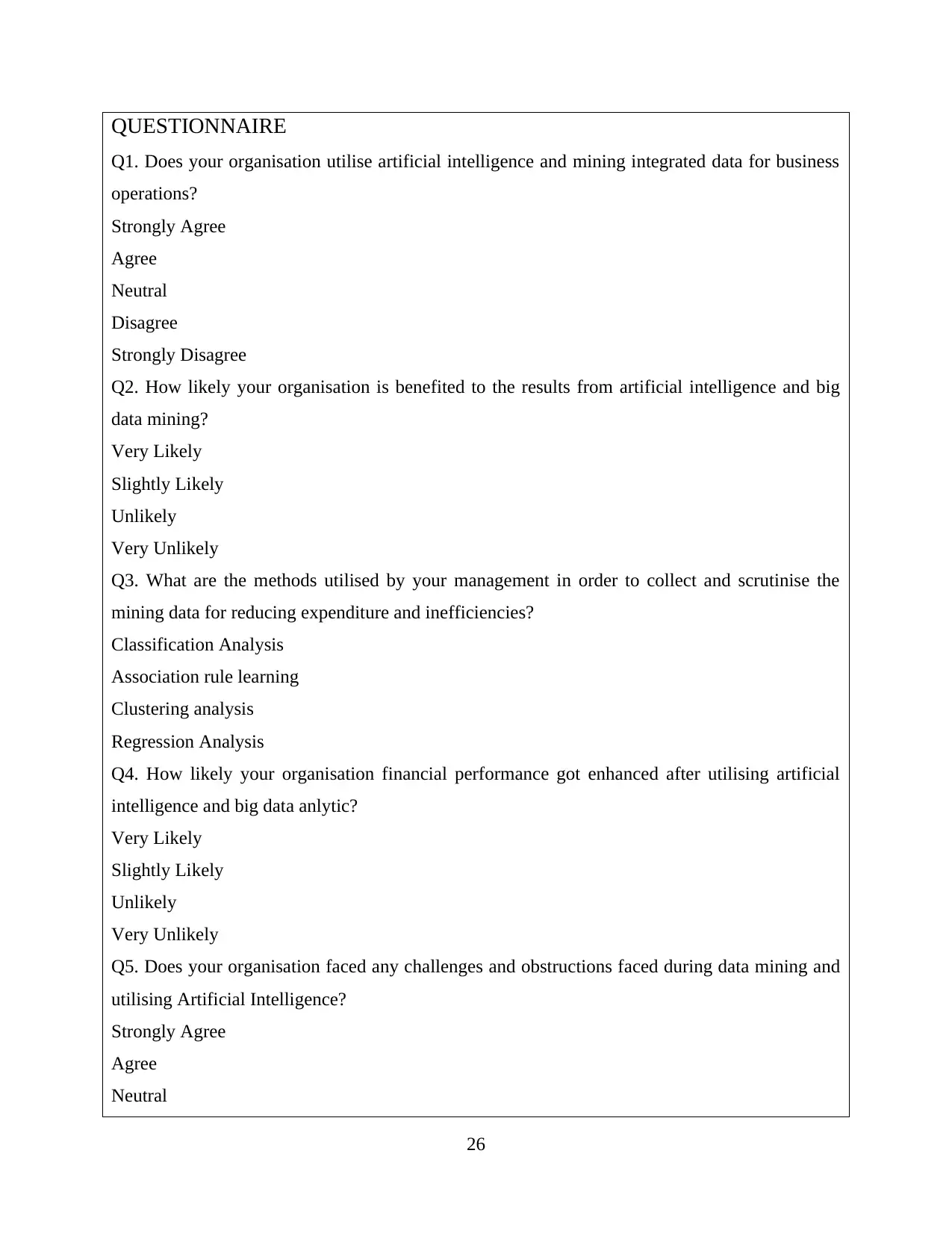
QUESTIONNAIRE
Q1. Does your organisation utilise artificial intelligence and mining integrated data for business
operations?
Strongly Agree
Agree
Neutral
Disagree
Strongly Disagree
Q2. How likely your organisation is benefited to the results from artificial intelligence and big
data mining?
Very Likely
Slightly Likely
Unlikely
Very Unlikely
Q3. What are the methods utilised by your management in order to collect and scrutinise the
mining data for reducing expenditure and inefficiencies?
Classification Analysis
Association rule learning
Clustering analysis
Regression Analysis
Q4. How likely your organisation financial performance got enhanced after utilising artificial
intelligence and big data anlytic?
Very Likely
Slightly Likely
Unlikely
Very Unlikely
Q5. Does your organisation faced any challenges and obstructions faced during data mining and
utilising Artificial Intelligence?
Strongly Agree
Agree
Neutral
26
Q1. Does your organisation utilise artificial intelligence and mining integrated data for business
operations?
Strongly Agree
Agree
Neutral
Disagree
Strongly Disagree
Q2. How likely your organisation is benefited to the results from artificial intelligence and big
data mining?
Very Likely
Slightly Likely
Unlikely
Very Unlikely
Q3. What are the methods utilised by your management in order to collect and scrutinise the
mining data for reducing expenditure and inefficiencies?
Classification Analysis
Association rule learning
Clustering analysis
Regression Analysis
Q4. How likely your organisation financial performance got enhanced after utilising artificial
intelligence and big data anlytic?
Very Likely
Slightly Likely
Unlikely
Very Unlikely
Q5. Does your organisation faced any challenges and obstructions faced during data mining and
utilising Artificial Intelligence?
Strongly Agree
Agree
Neutral
26
Secure Best Marks with AI Grader
Need help grading? Try our AI Grader for instant feedback on your assignments.
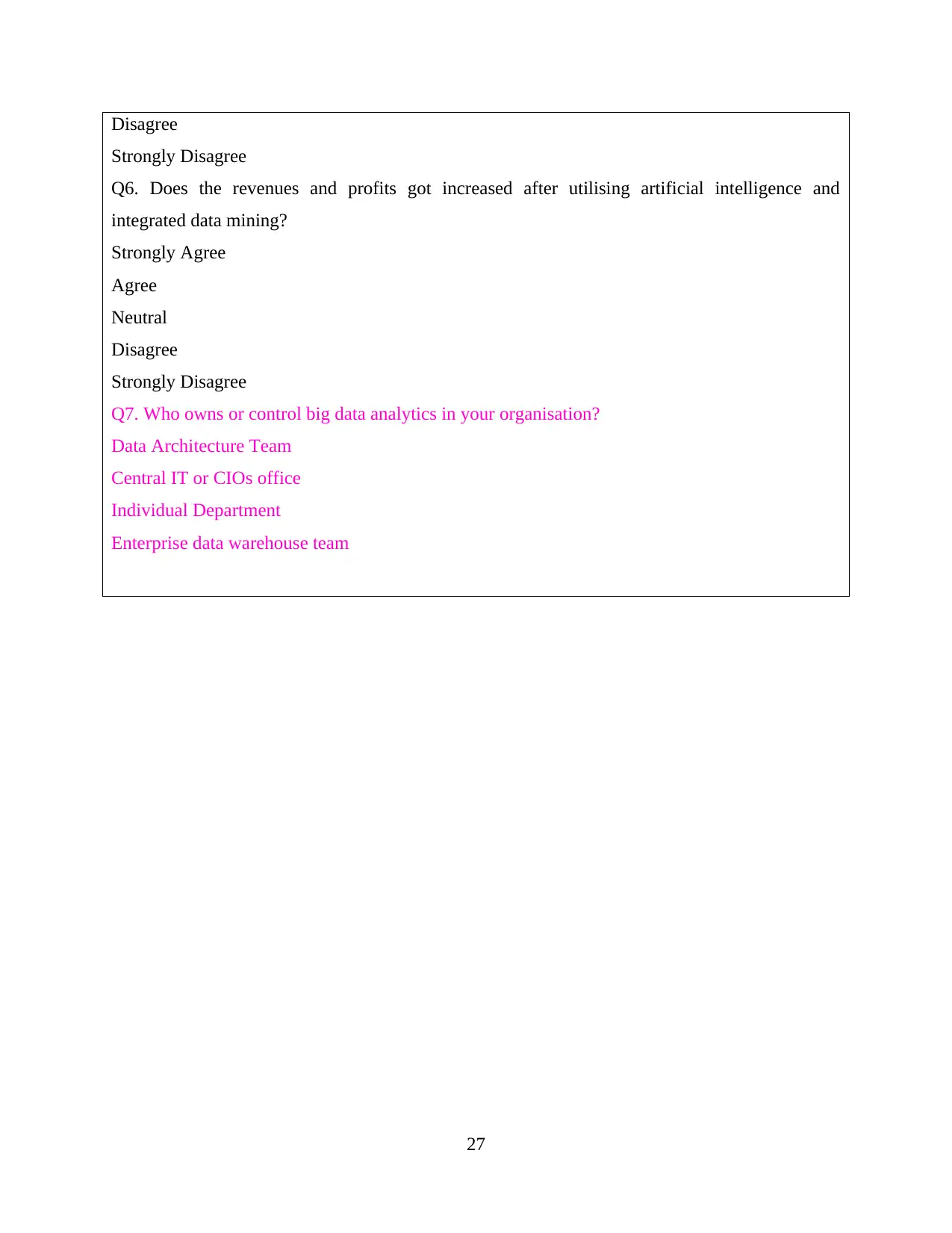
Disagree
Strongly Disagree
Q6. Does the revenues and profits got increased after utilising artificial intelligence and
integrated data mining?
Strongly Agree
Agree
Neutral
Disagree
Strongly Disagree
Q7. Who owns or control big data analytics in your organisation?
Data Architecture Team
Central IT or CIOs office
Individual Department
Enterprise data warehouse team
27
Strongly Disagree
Q6. Does the revenues and profits got increased after utilising artificial intelligence and
integrated data mining?
Strongly Agree
Agree
Neutral
Disagree
Strongly Disagree
Q7. Who owns or control big data analytics in your organisation?
Data Architecture Team
Central IT or CIOs office
Individual Department
Enterprise data warehouse team
27
1 out of 29
Related Documents
Your All-in-One AI-Powered Toolkit for Academic Success.
+13062052269
info@desklib.com
Available 24*7 on WhatsApp / Email
![[object Object]](/_next/static/media/star-bottom.7253800d.svg)
Unlock your academic potential
© 2024 | Zucol Services PVT LTD | All rights reserved.





